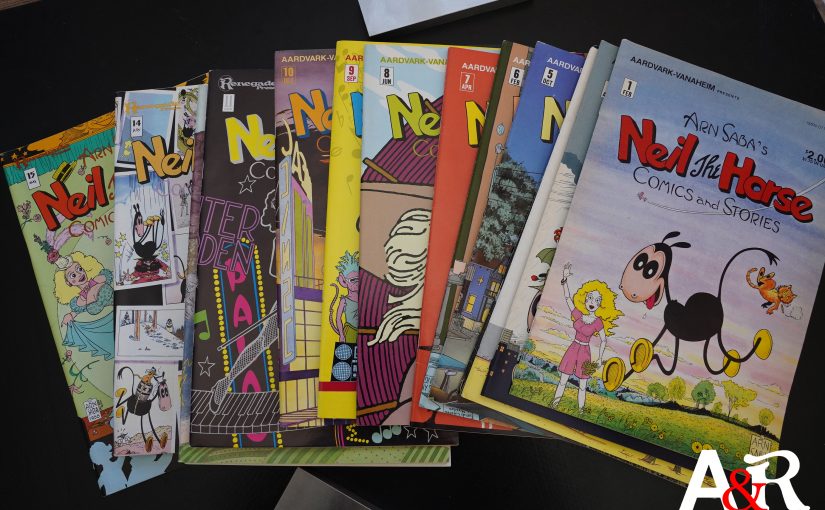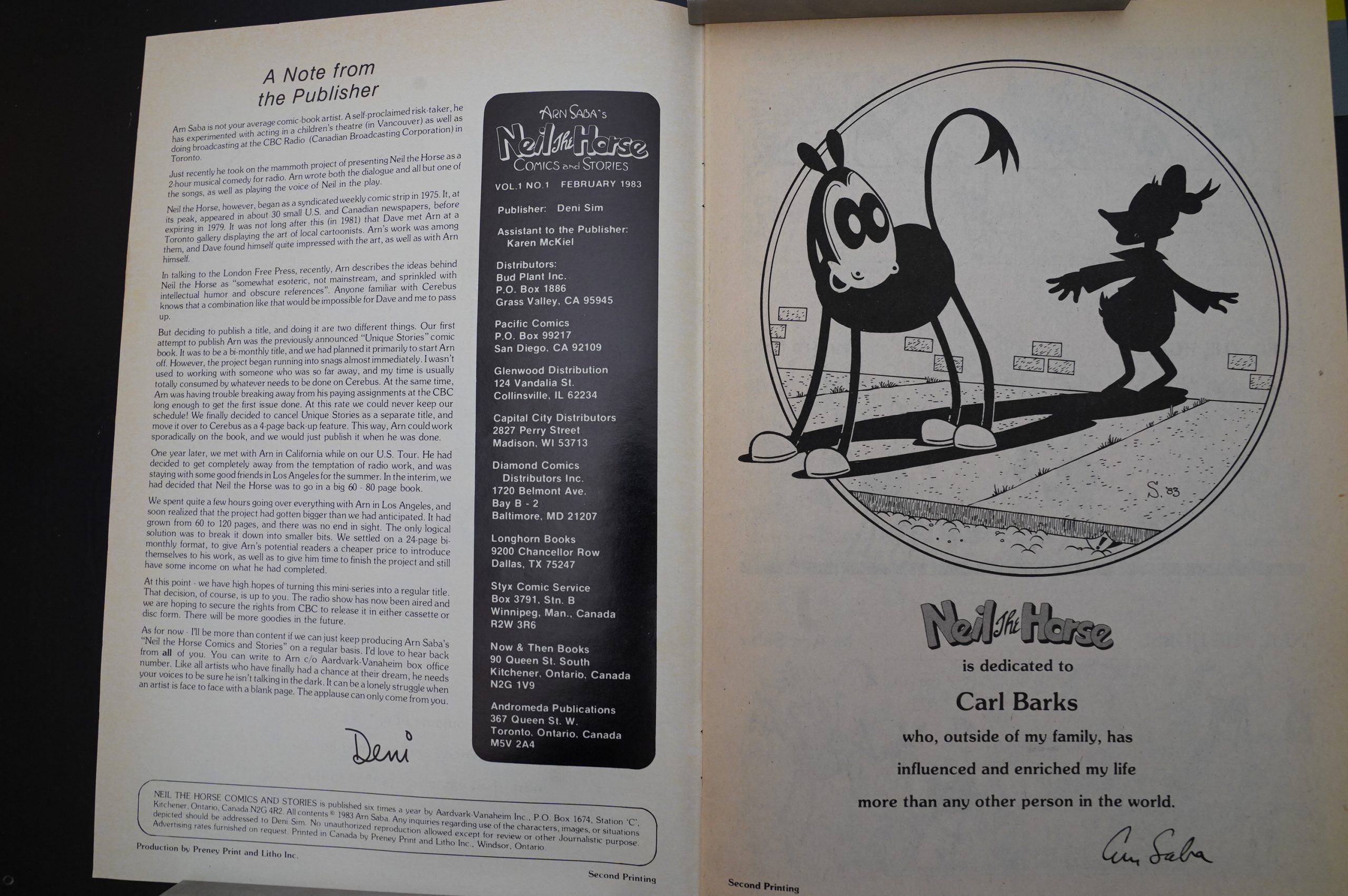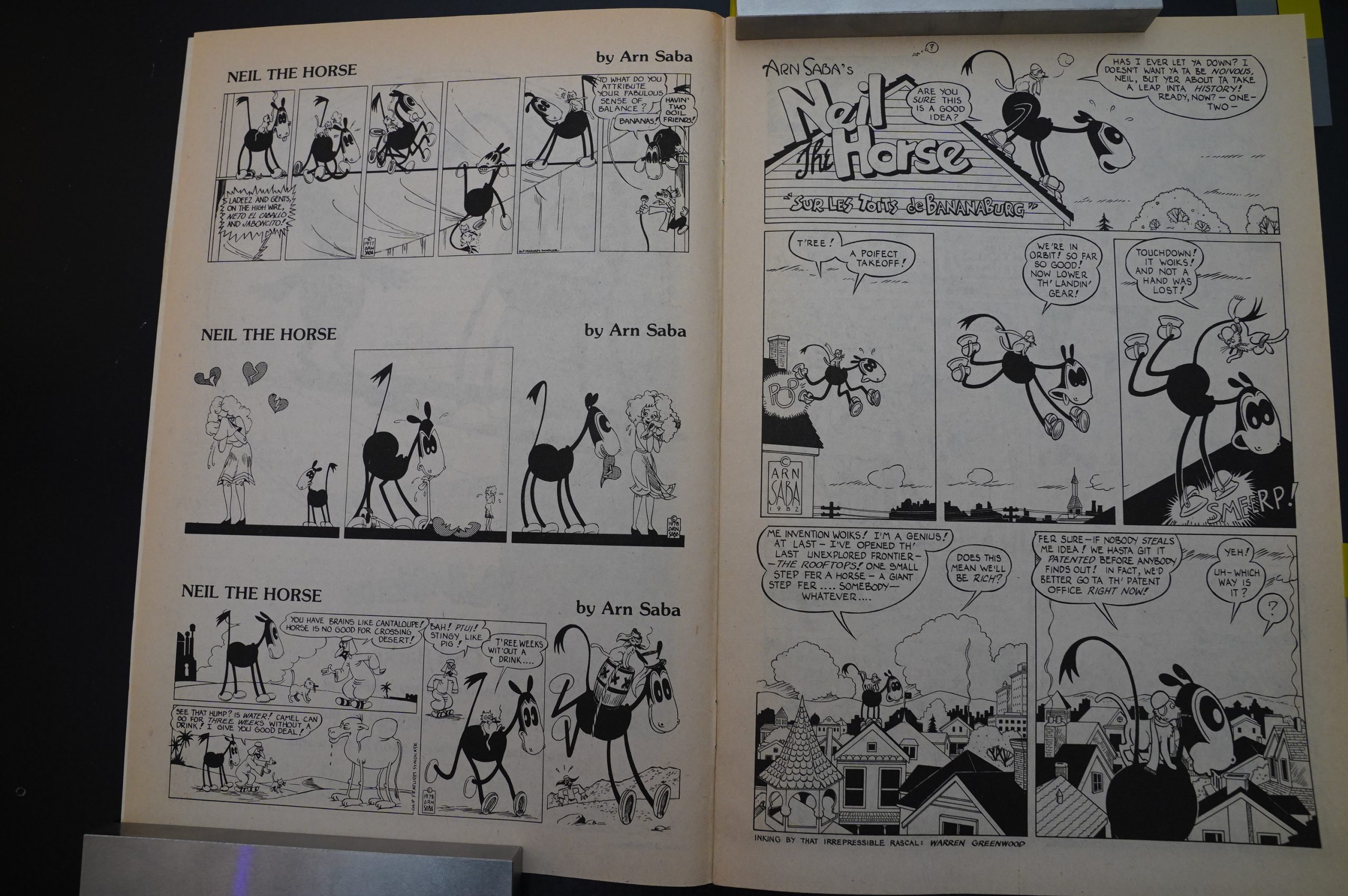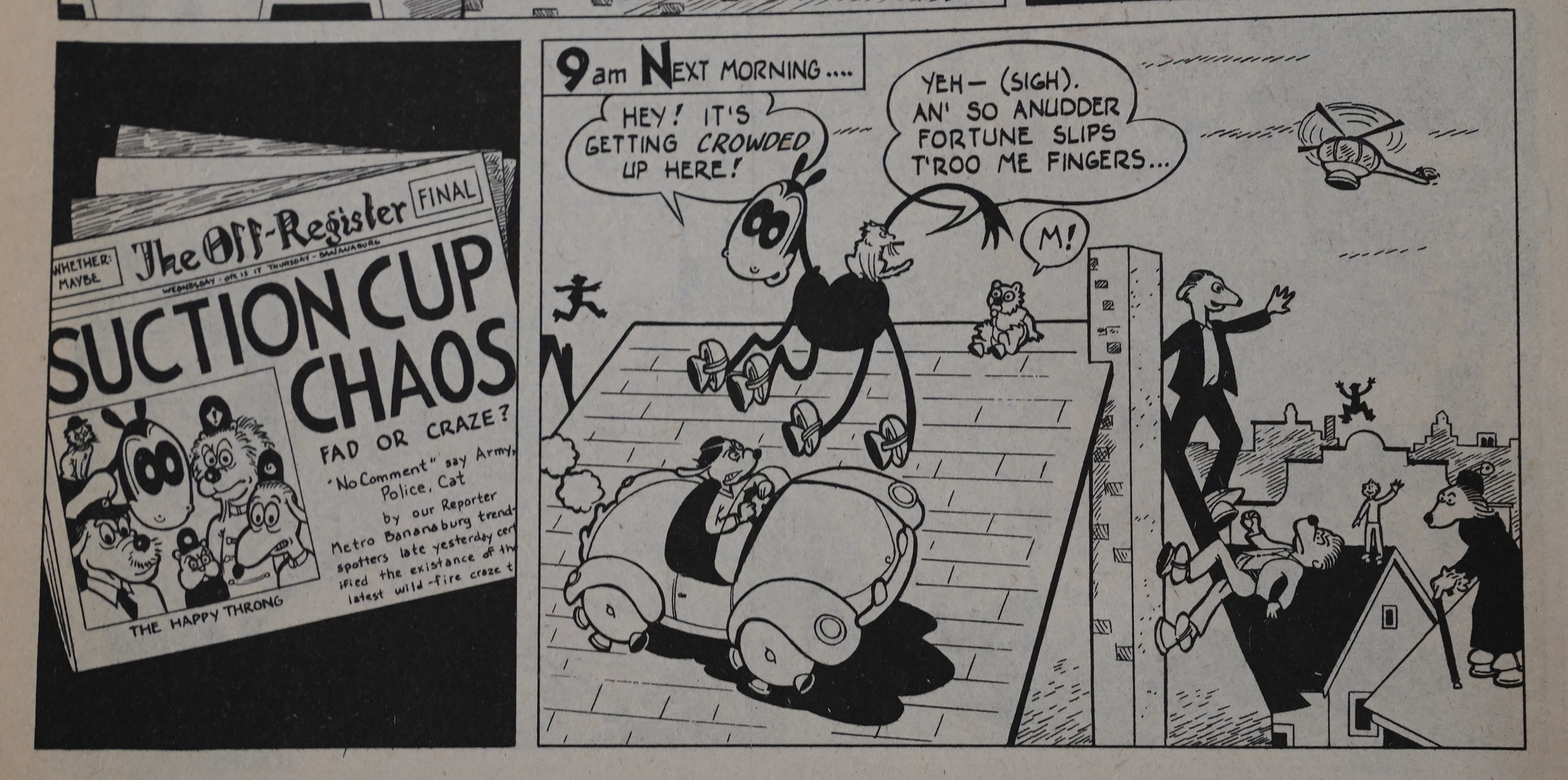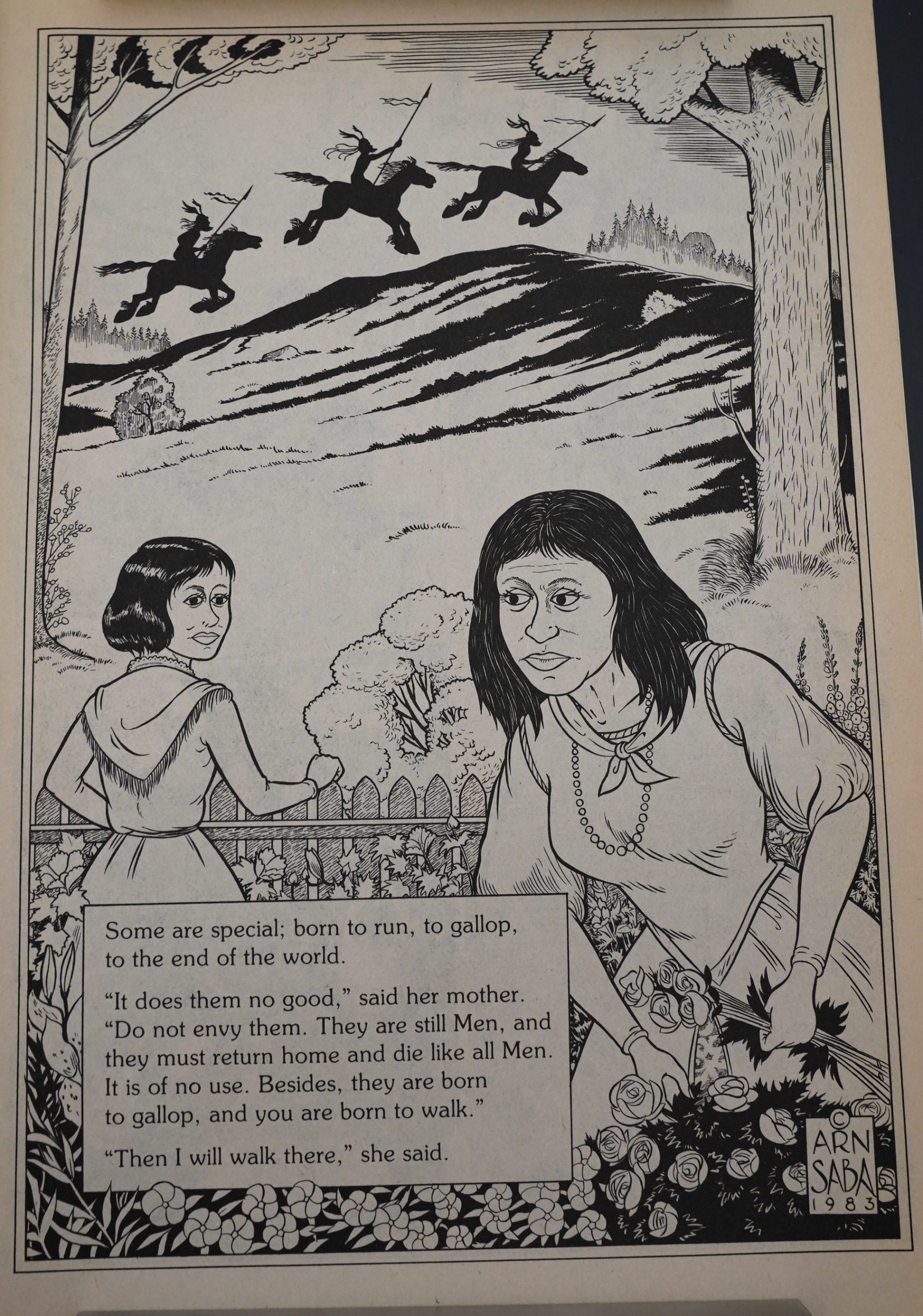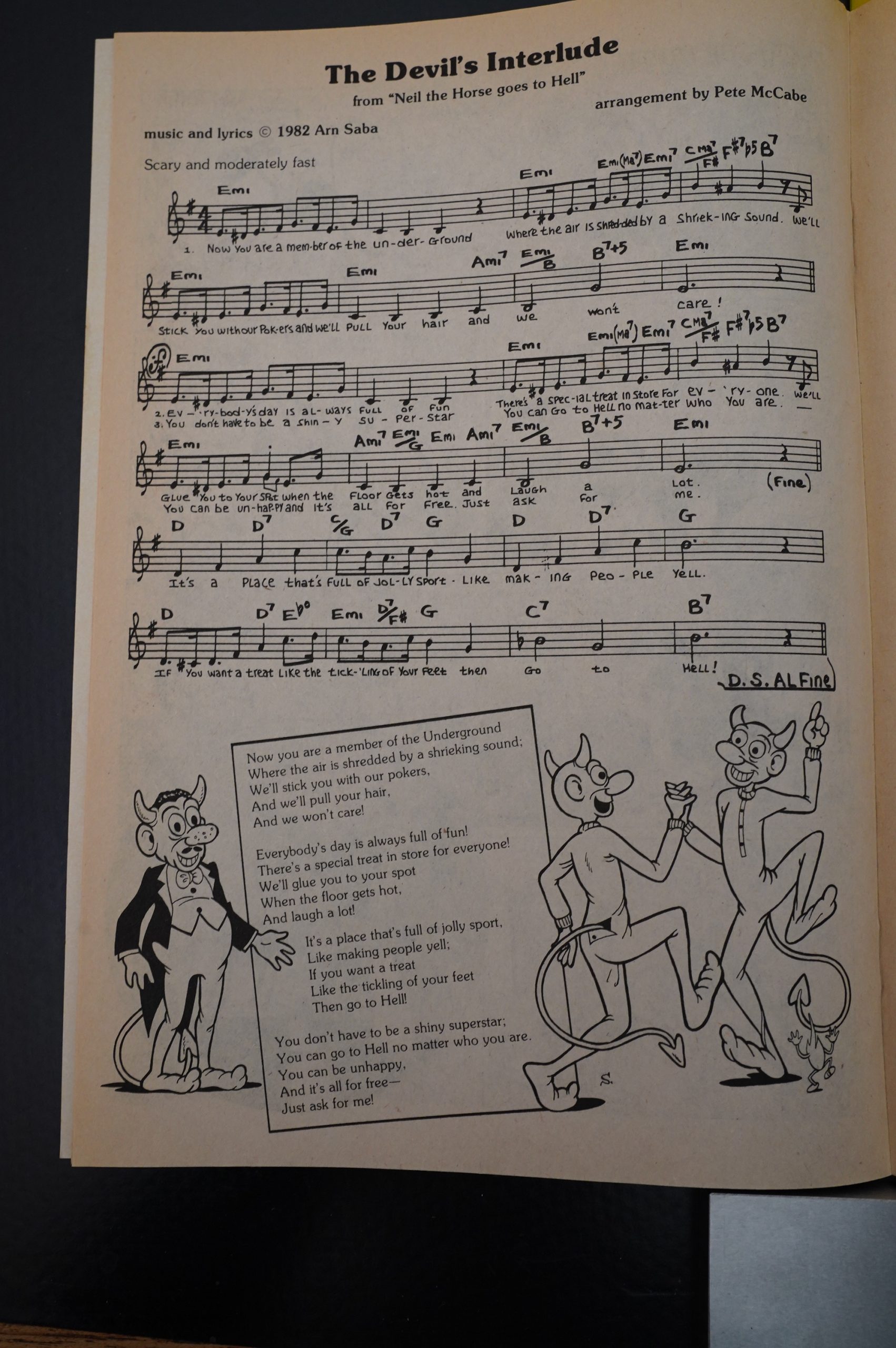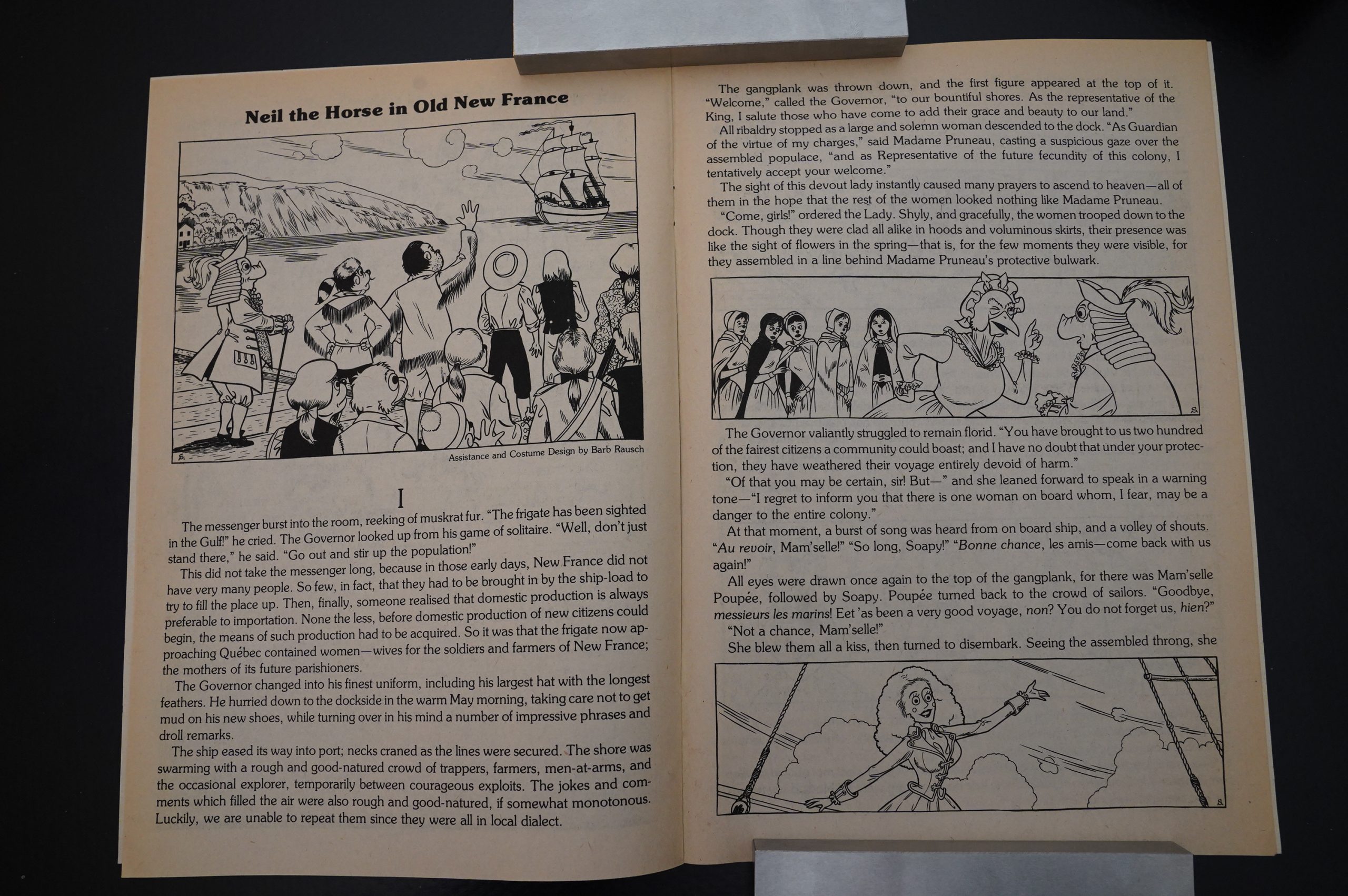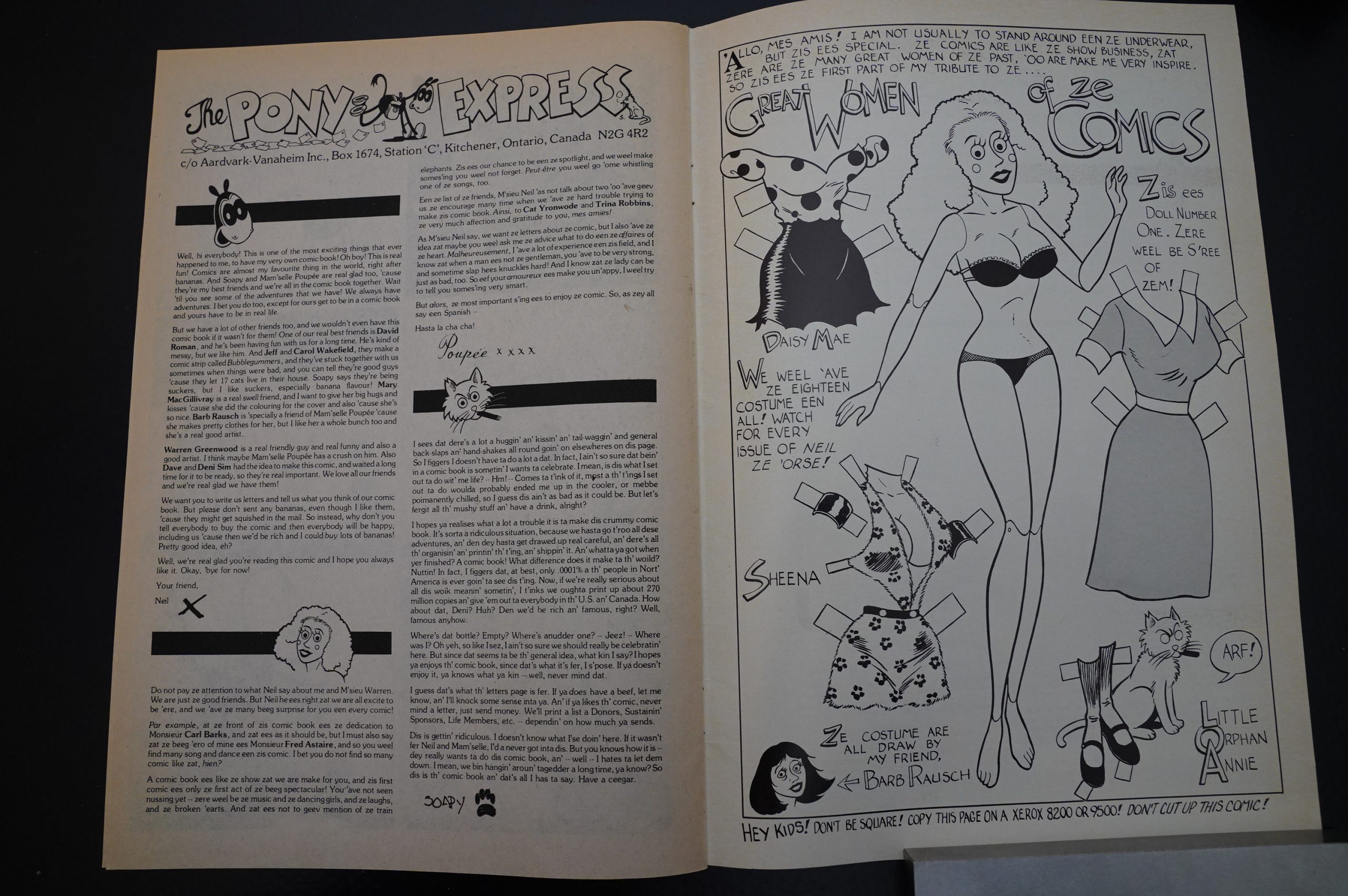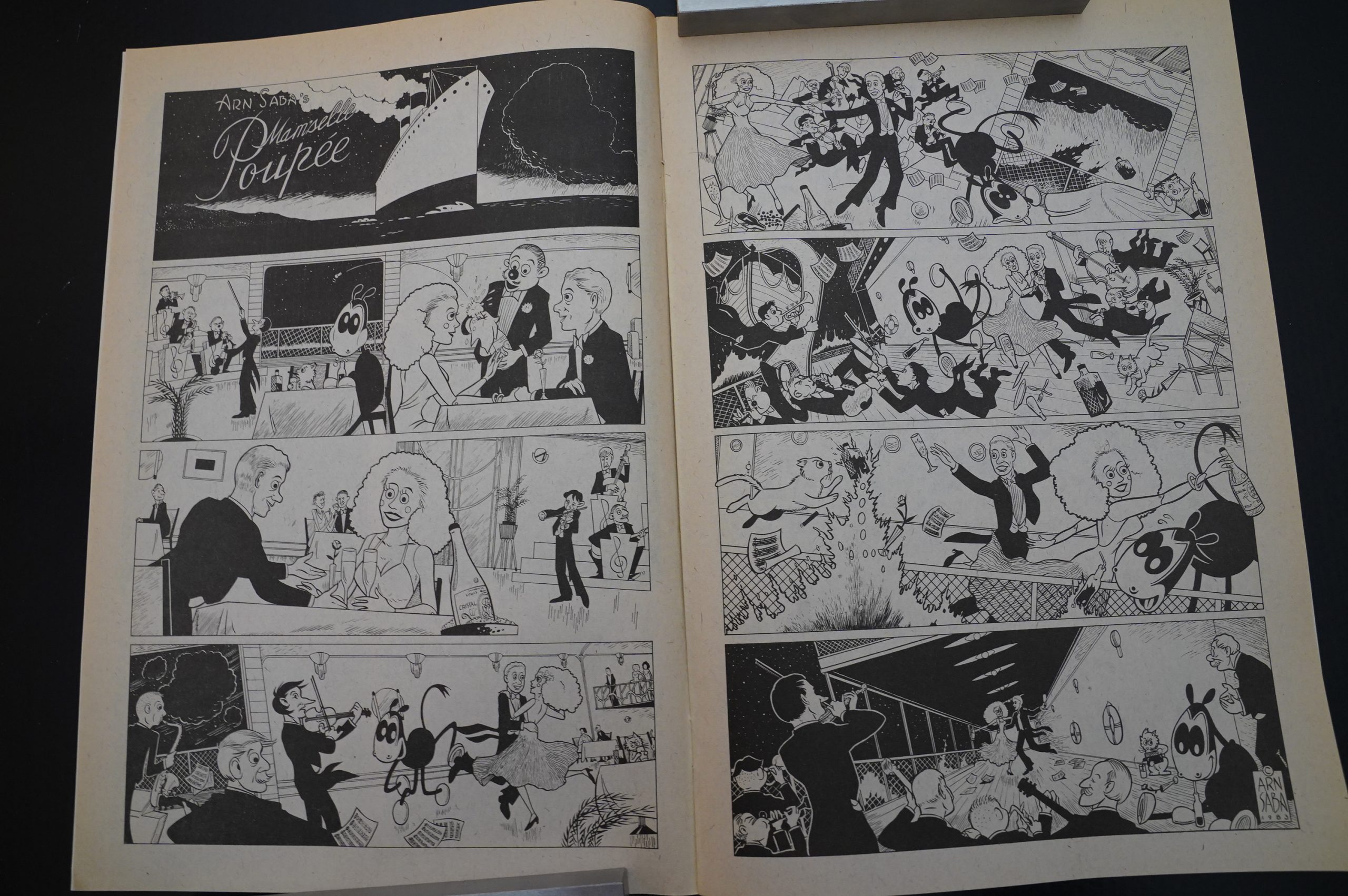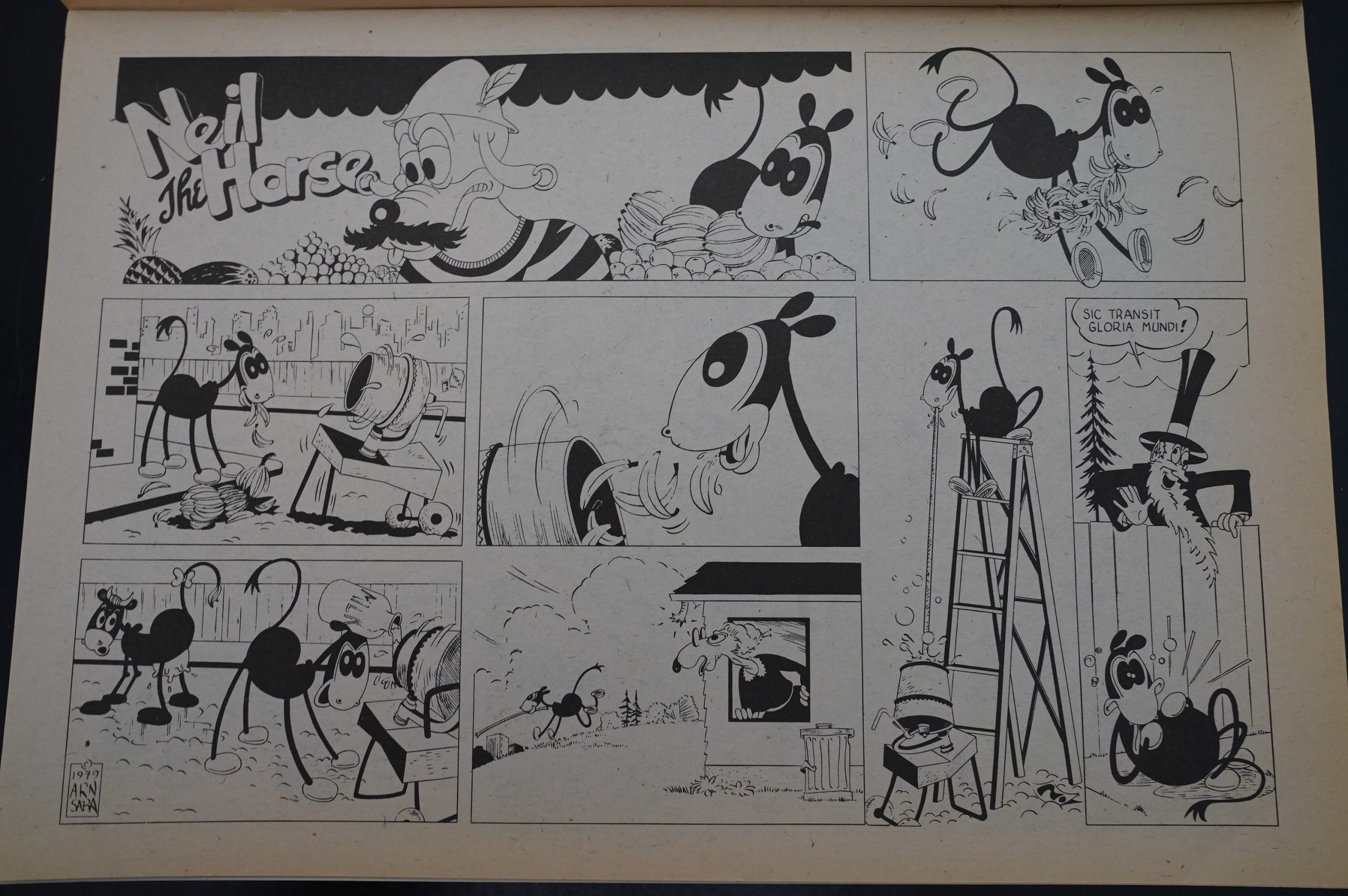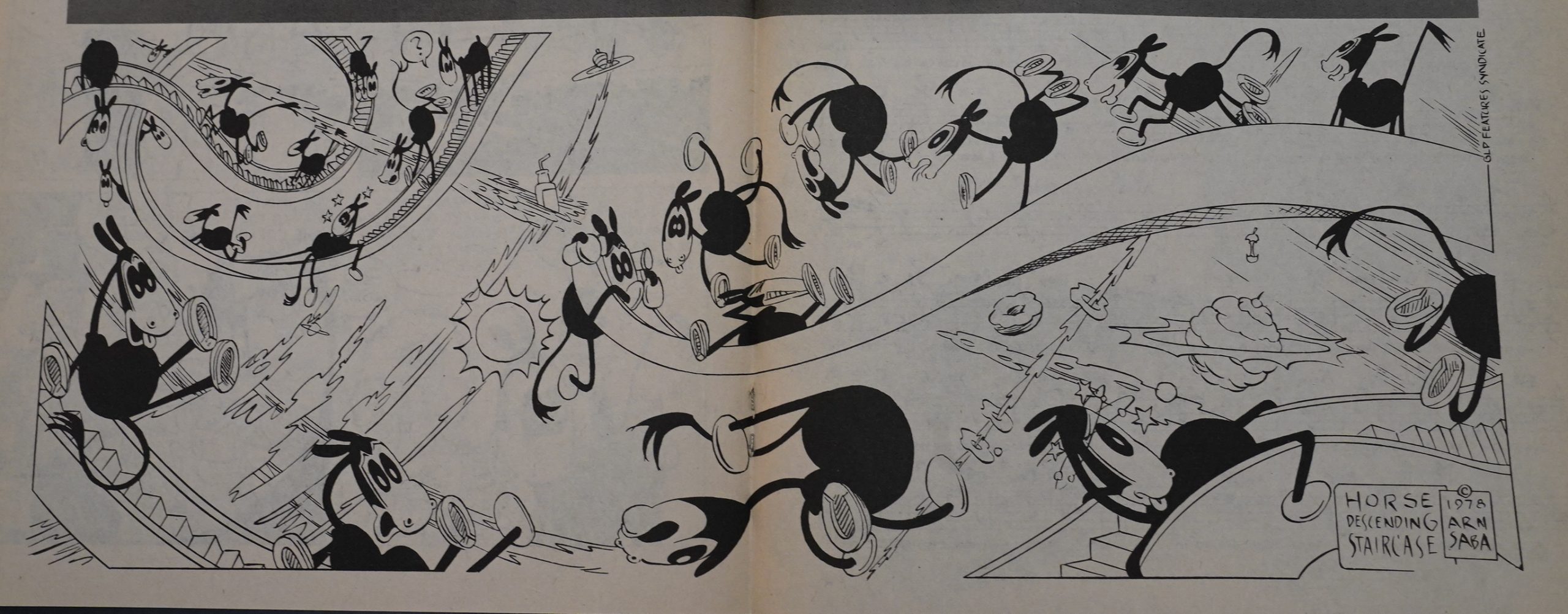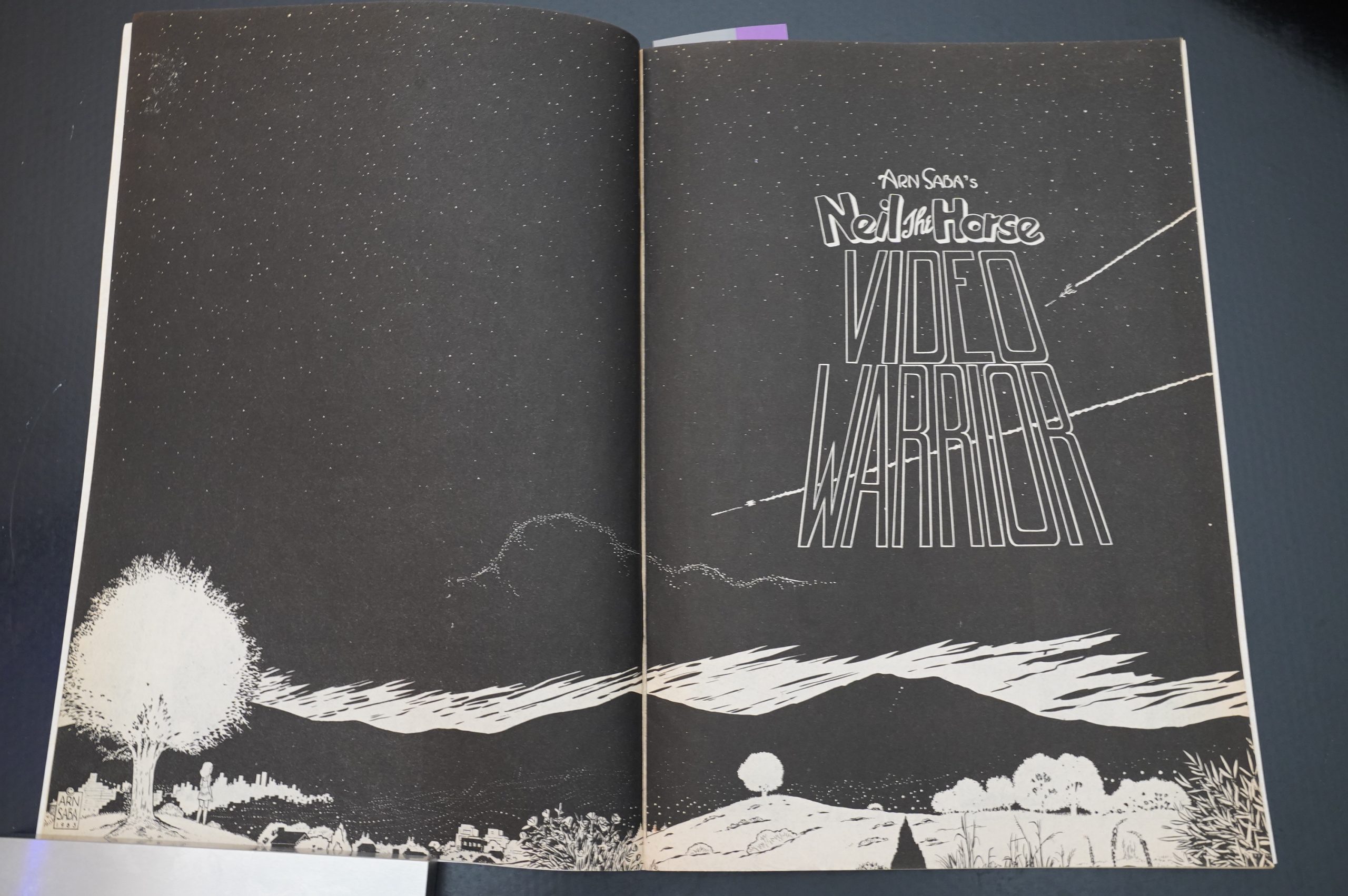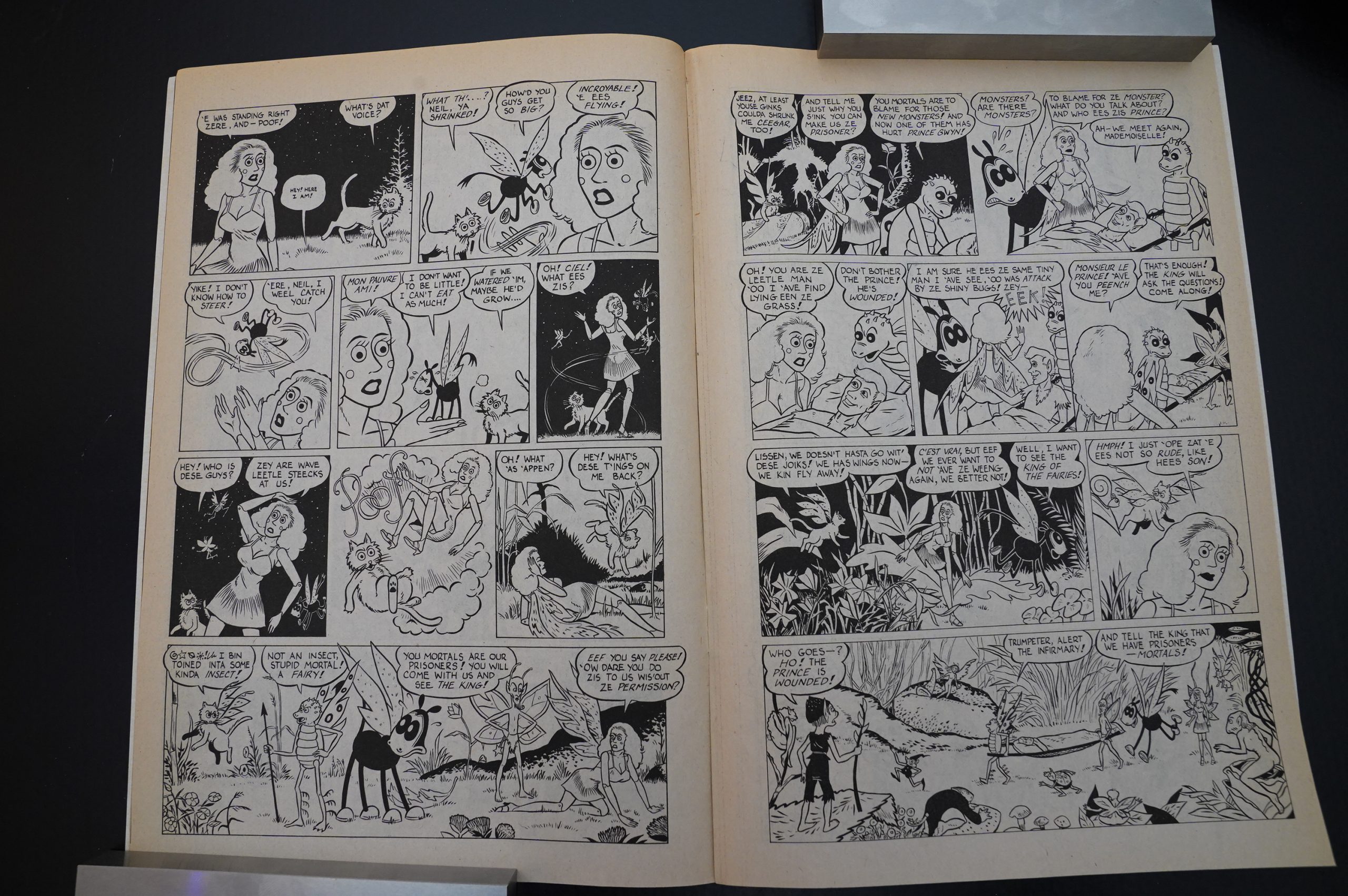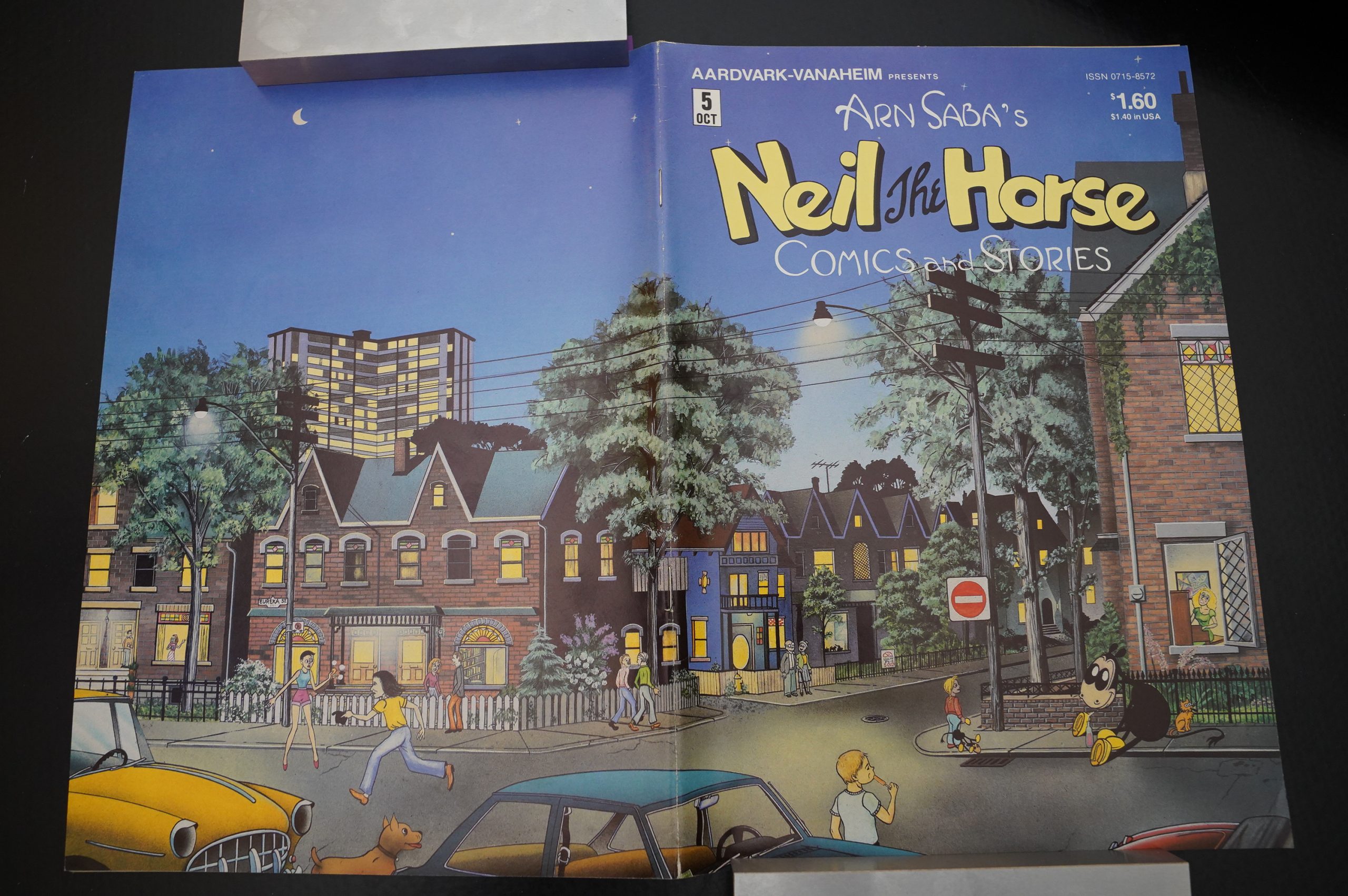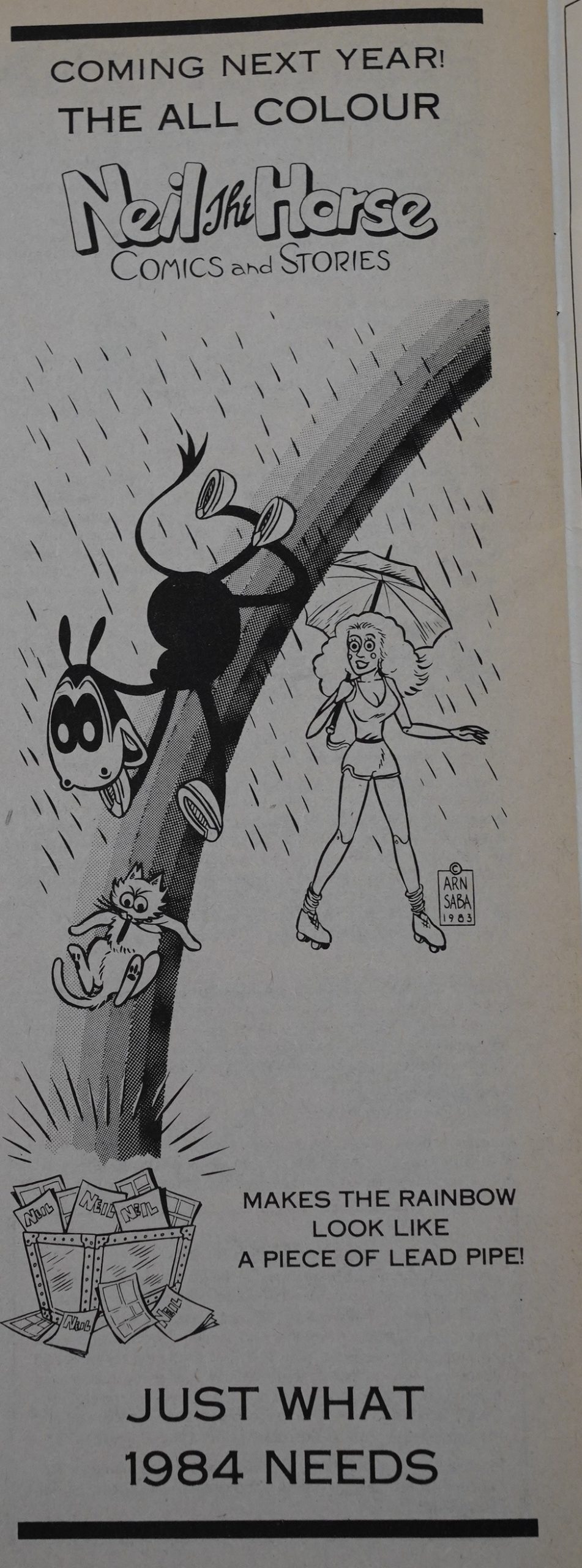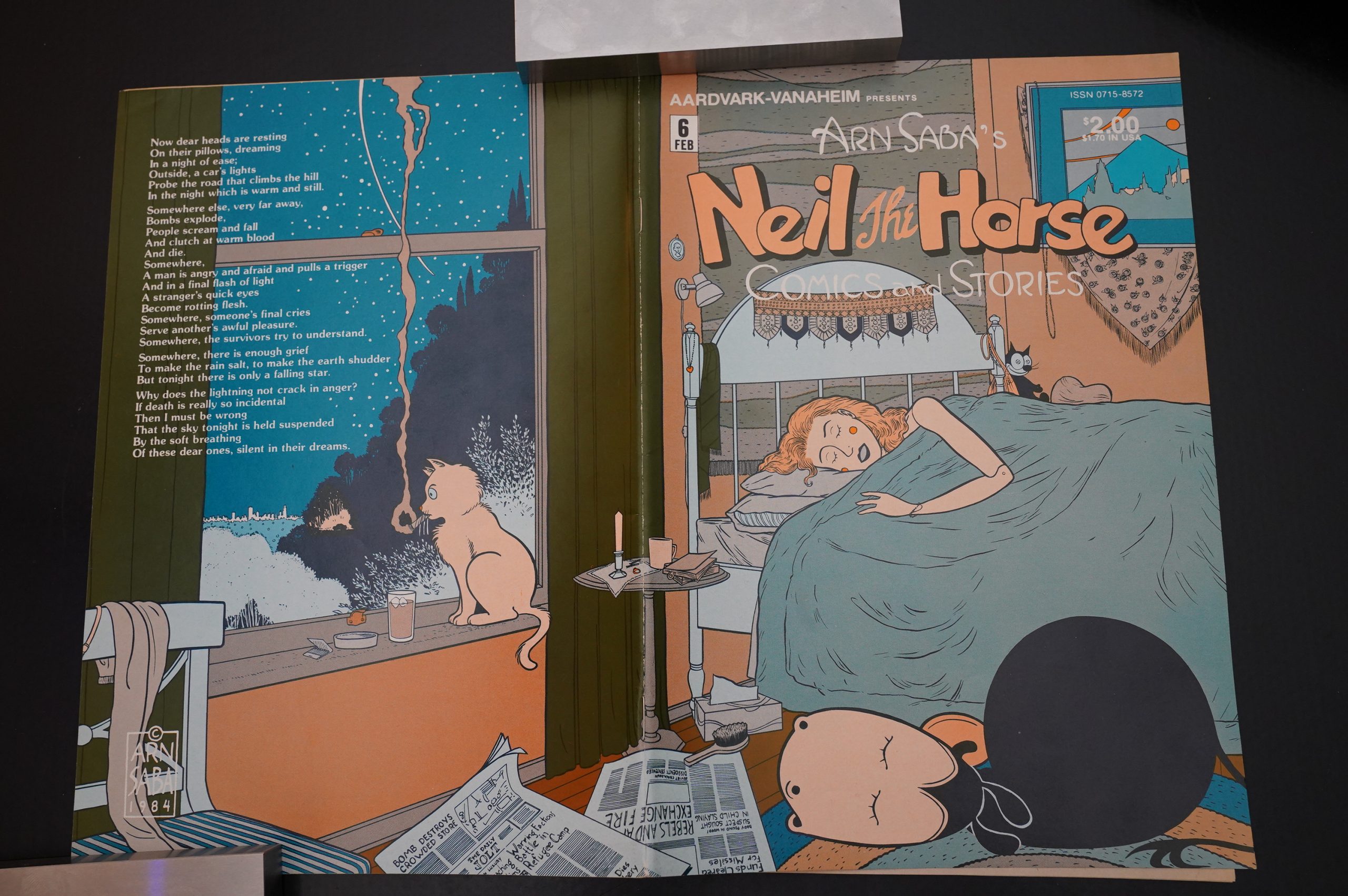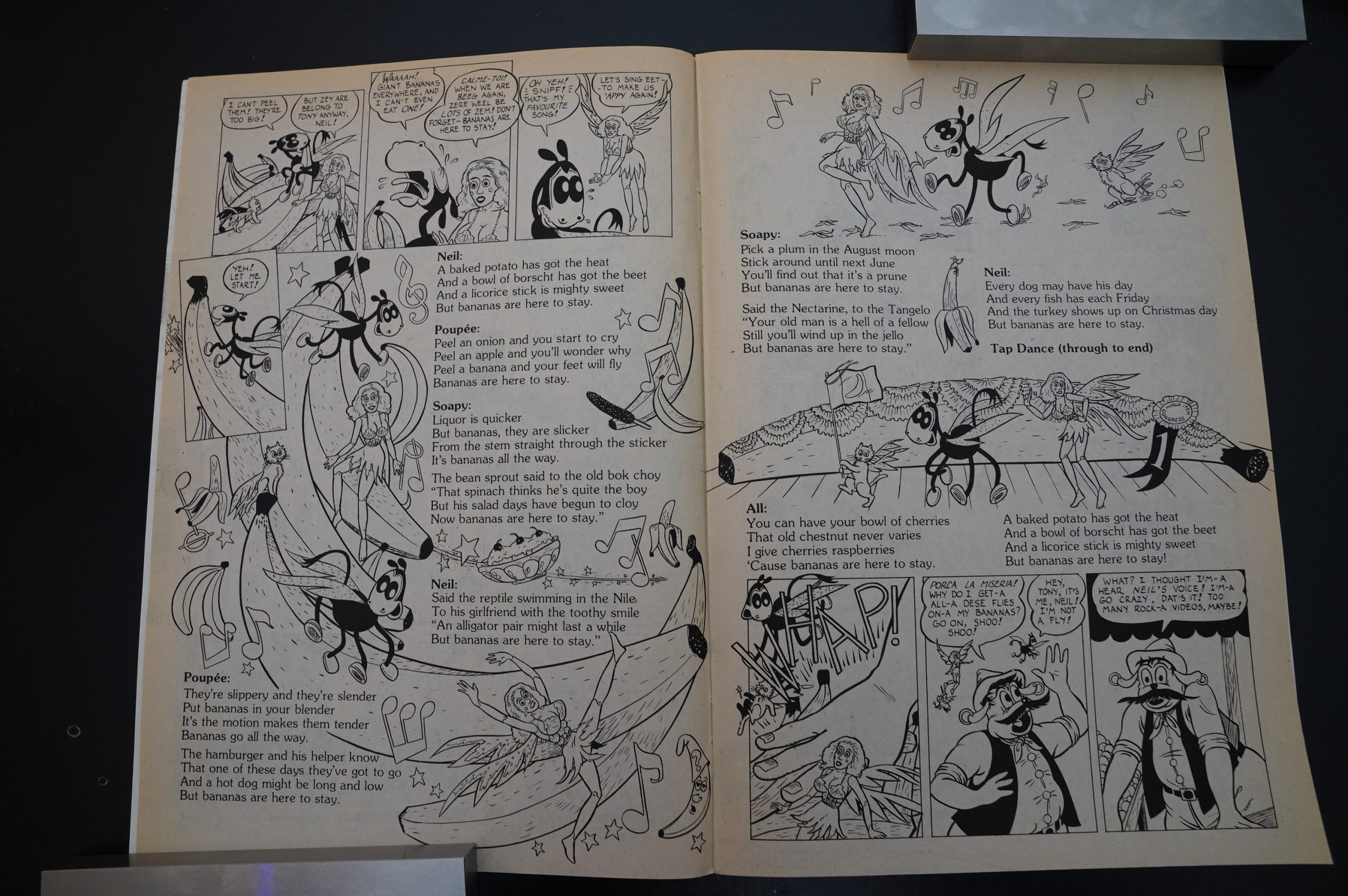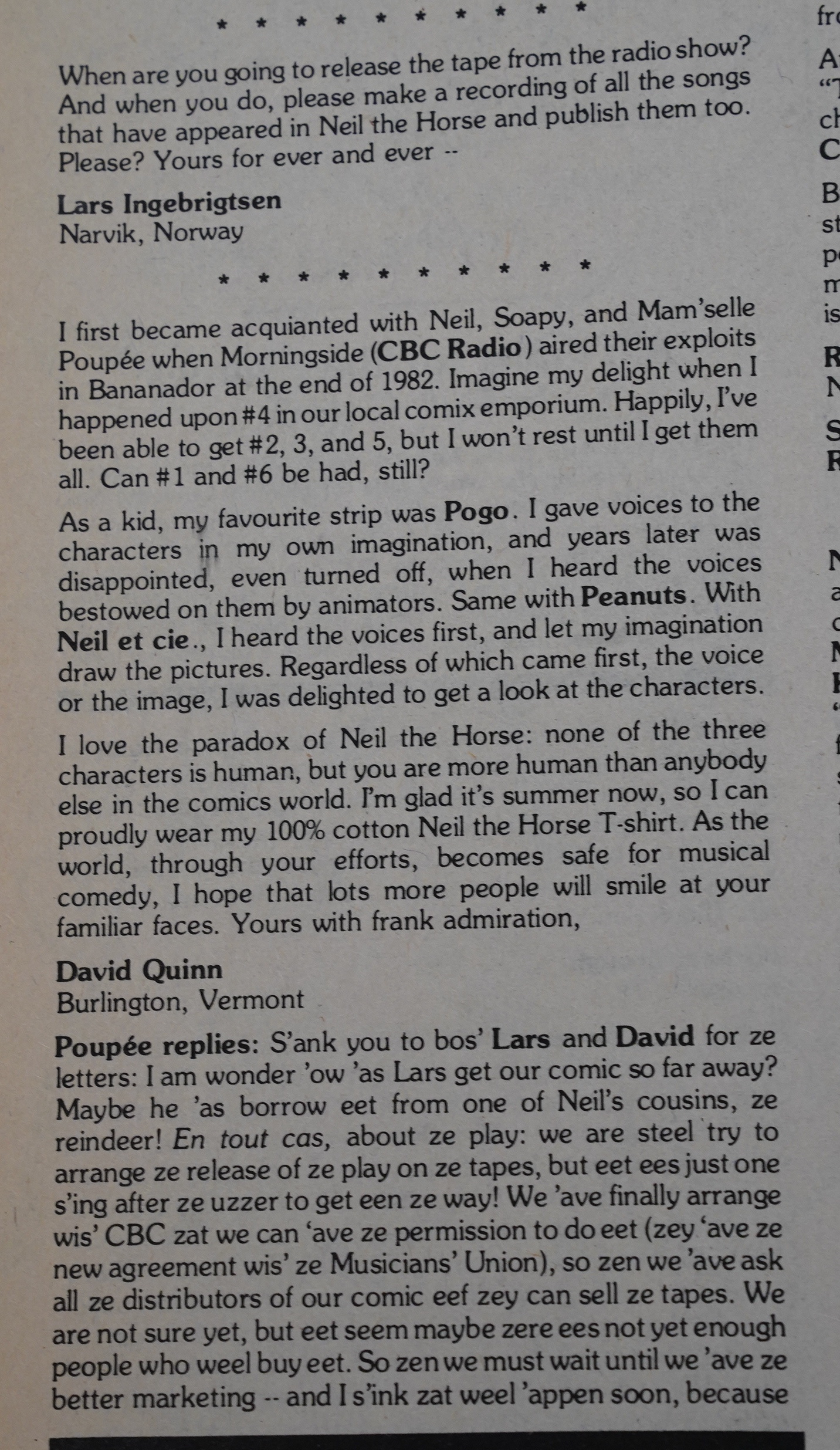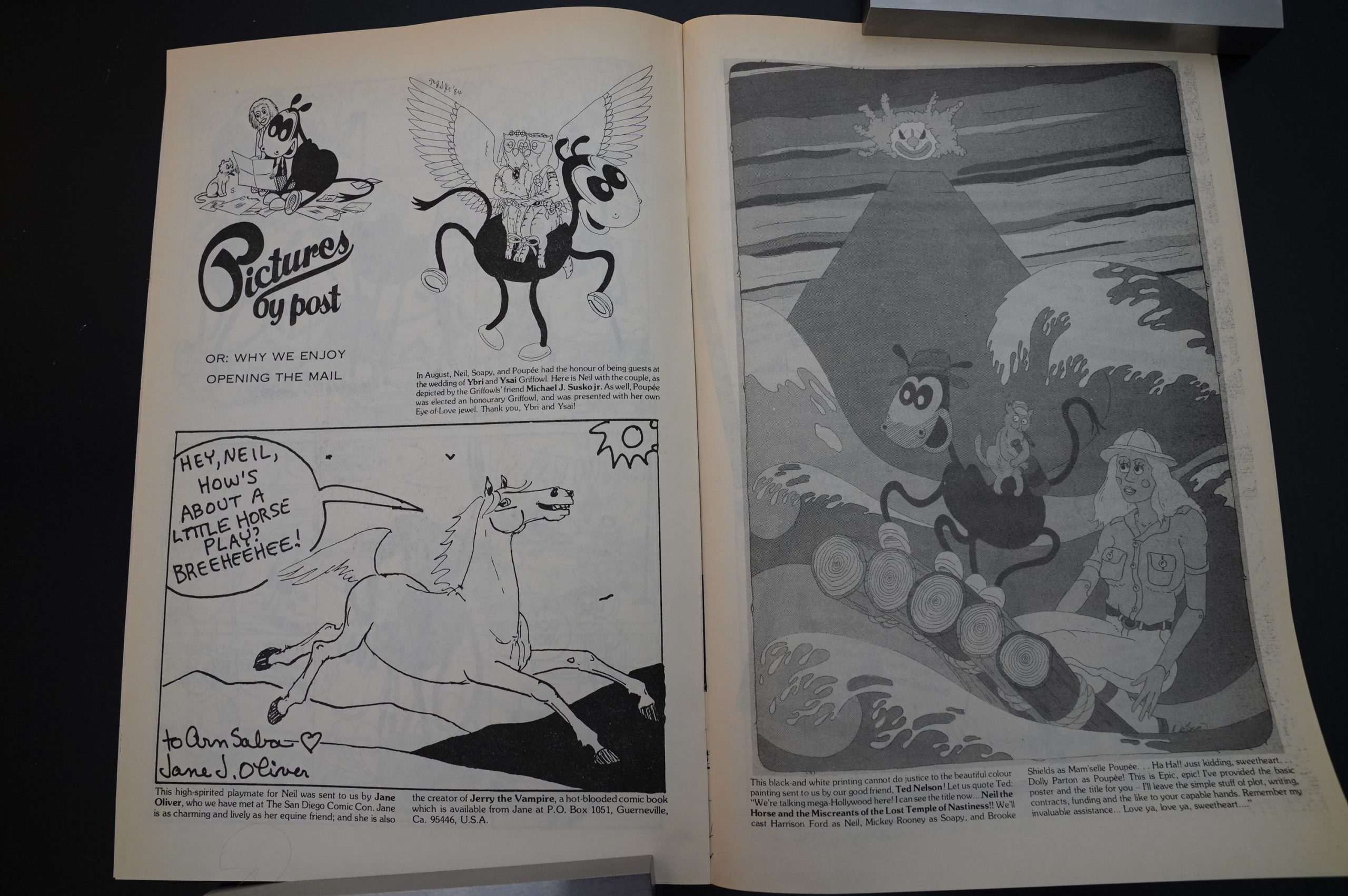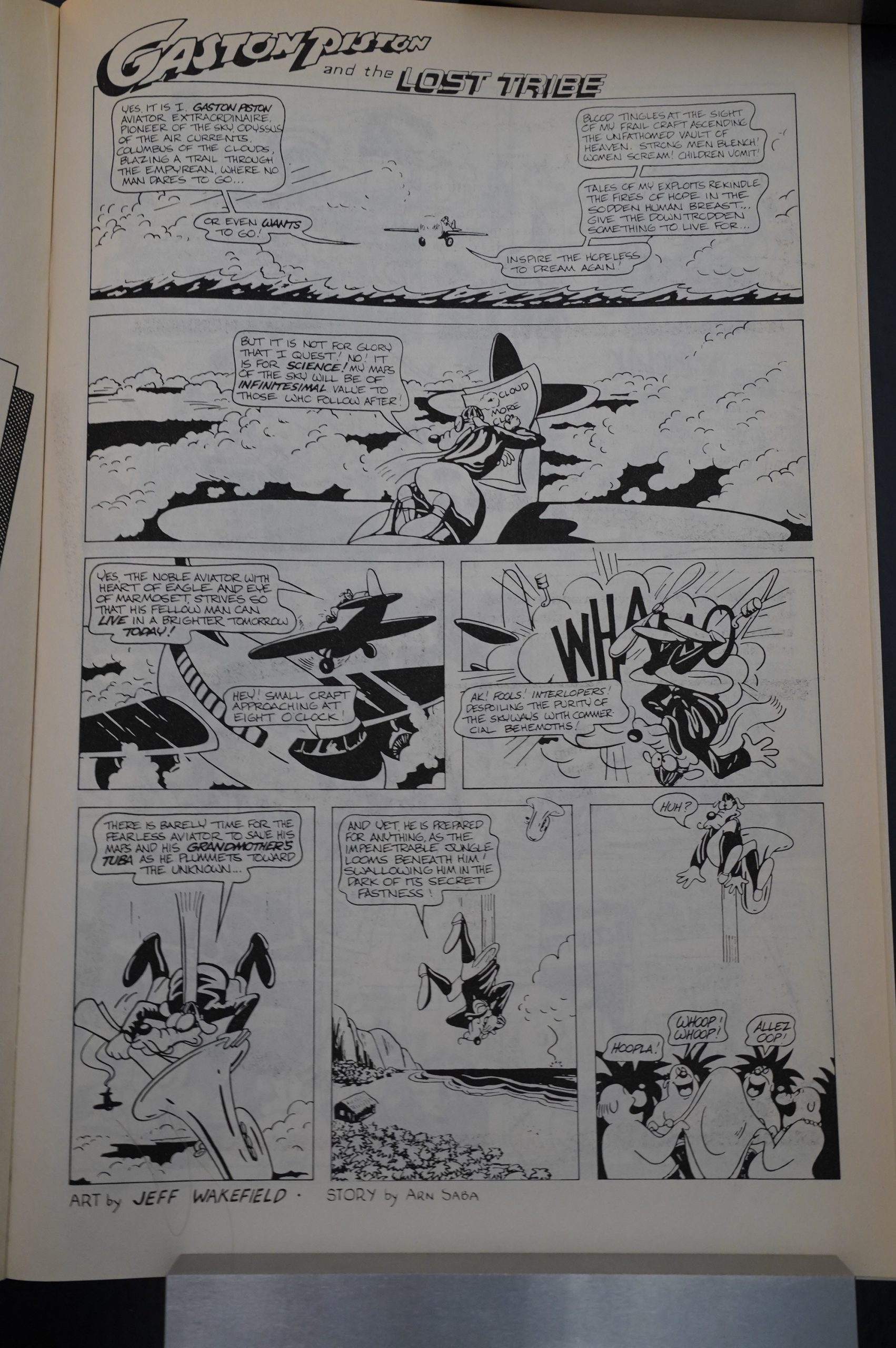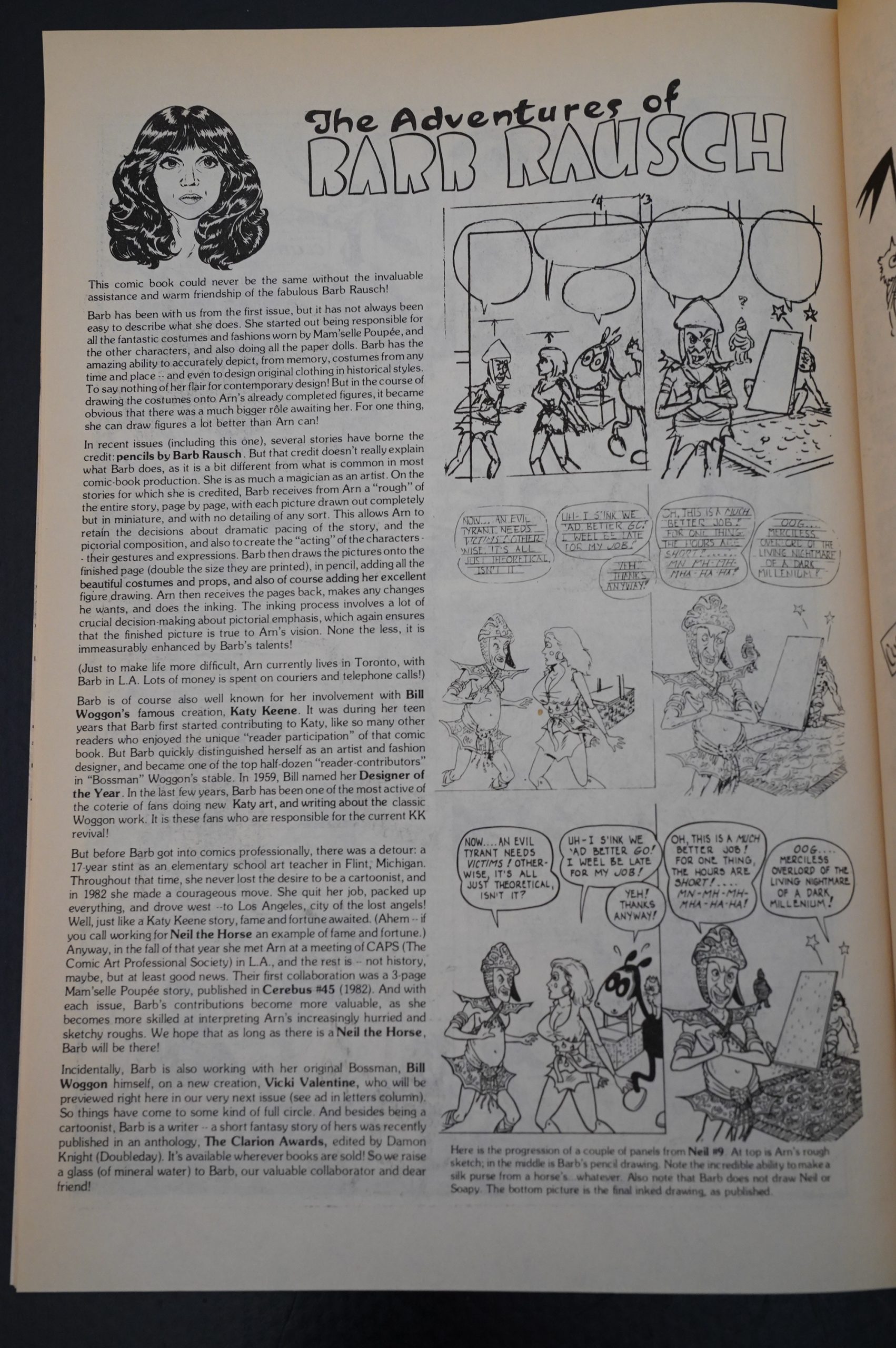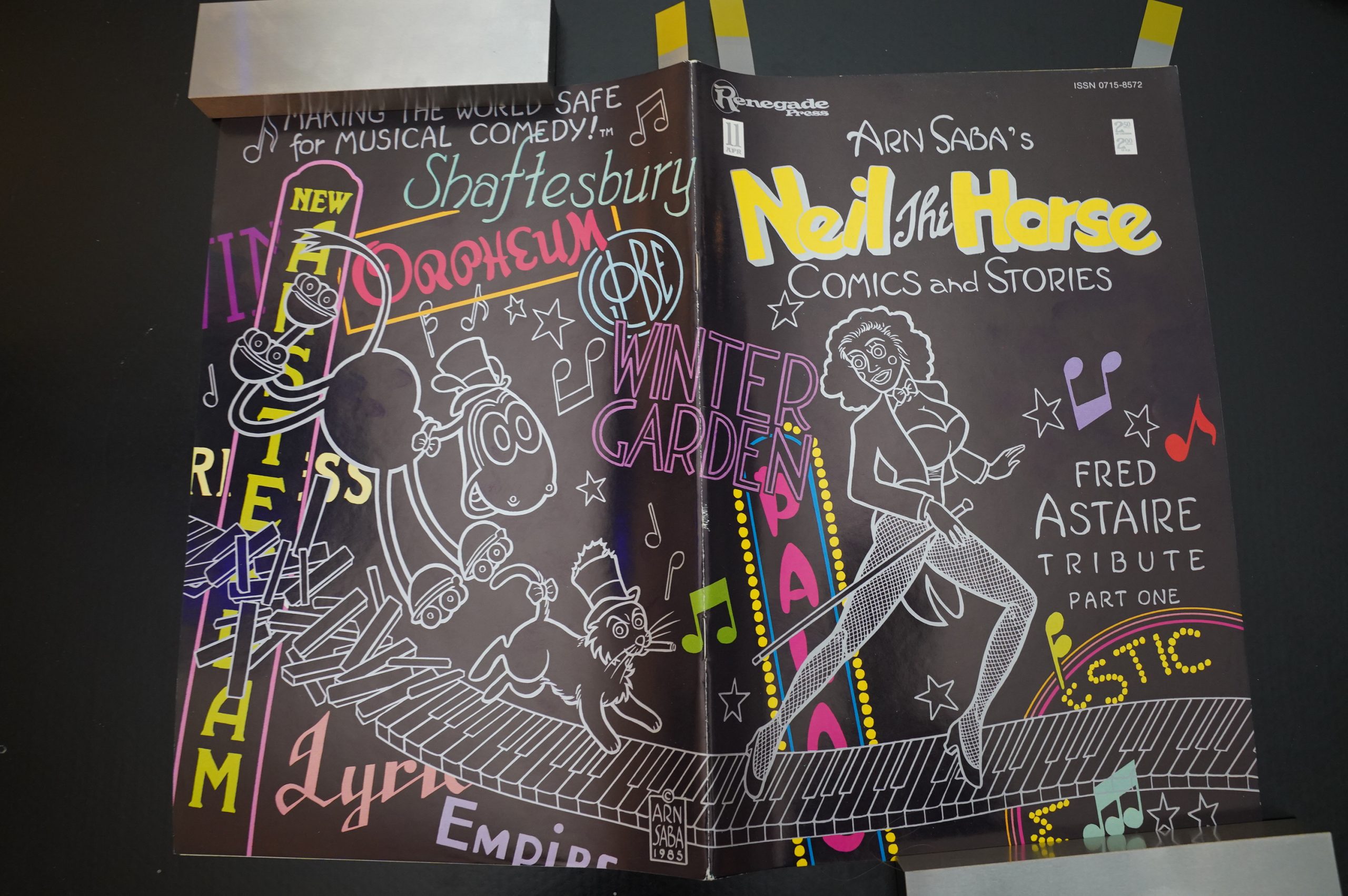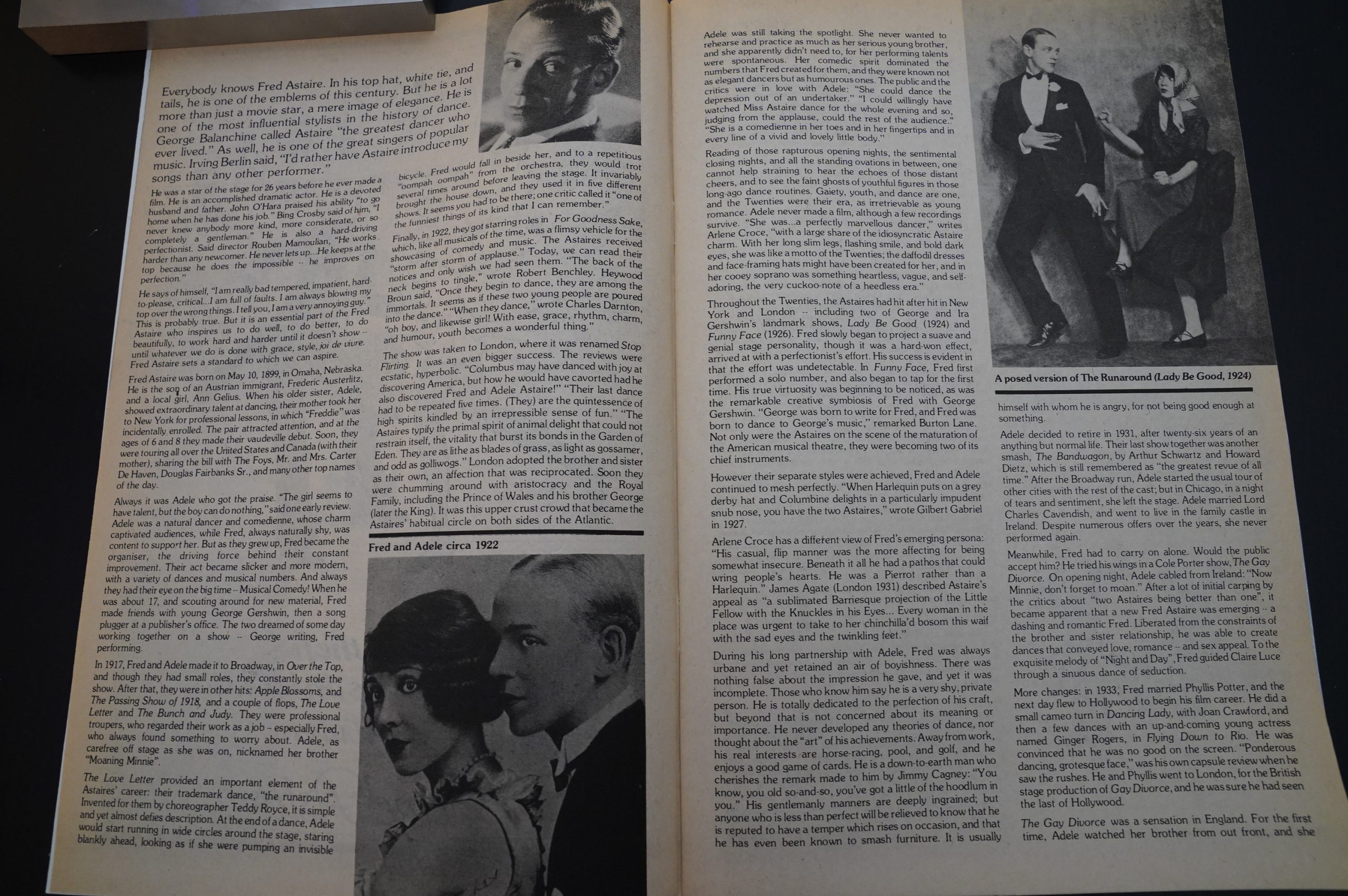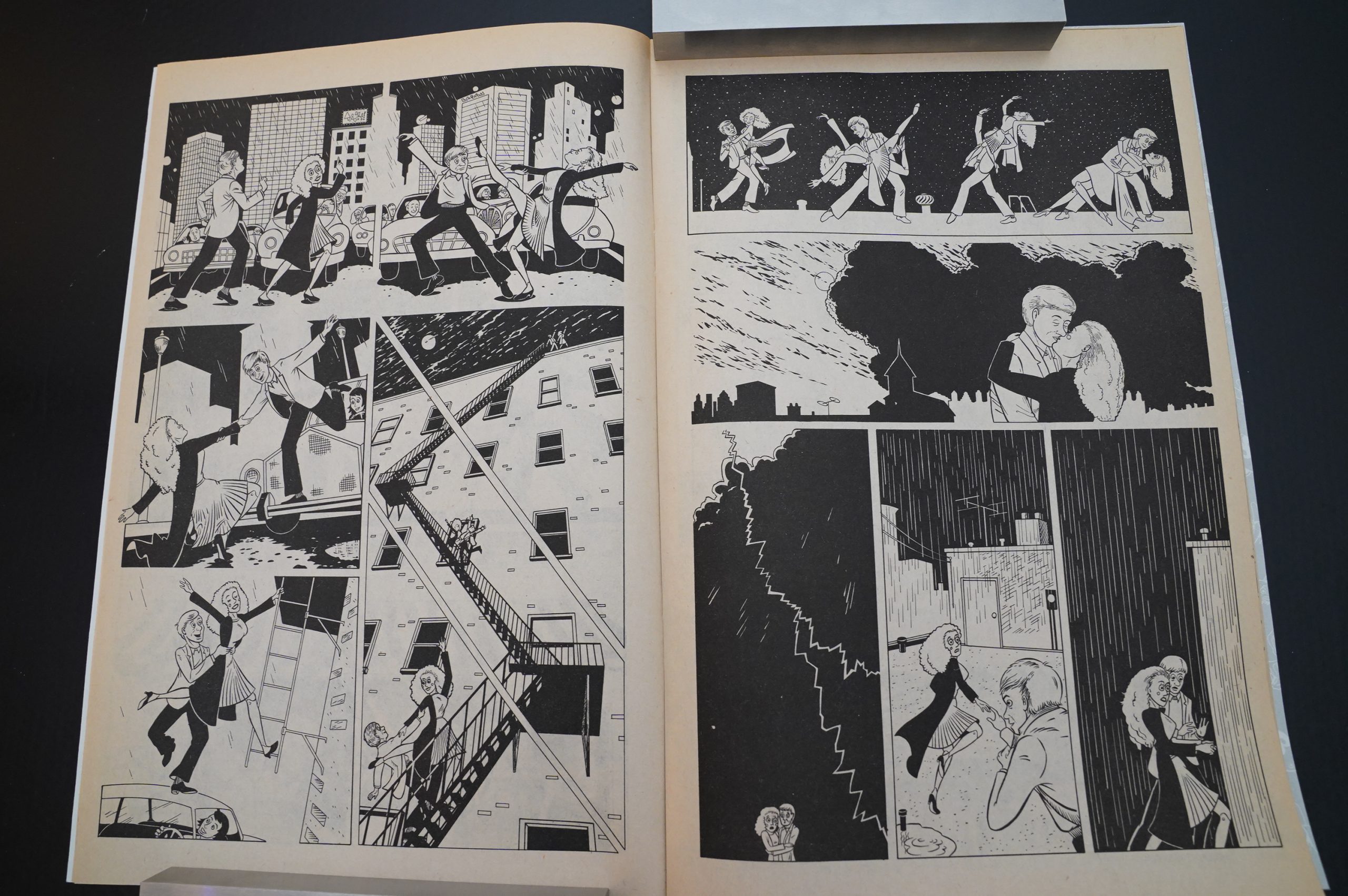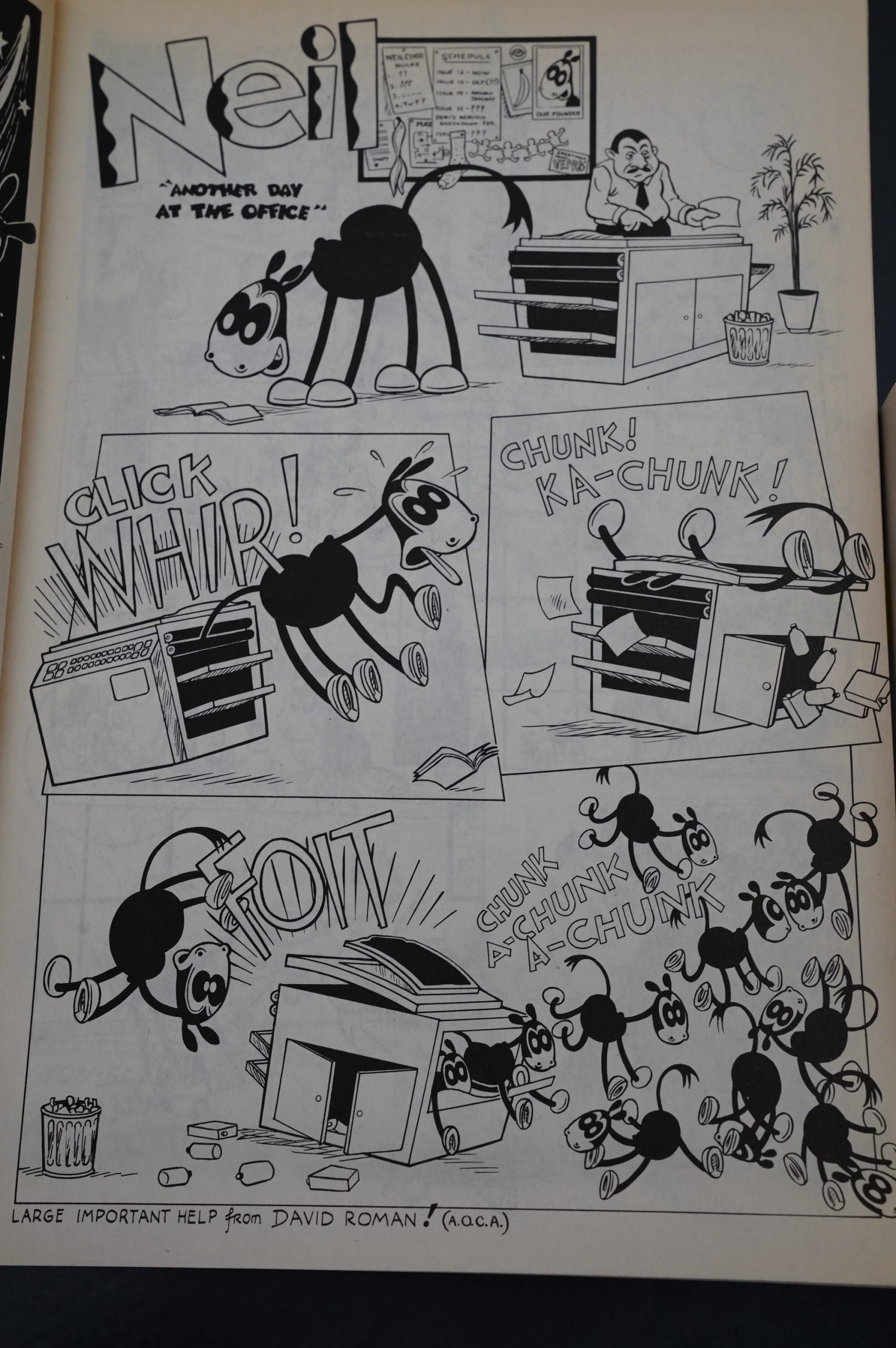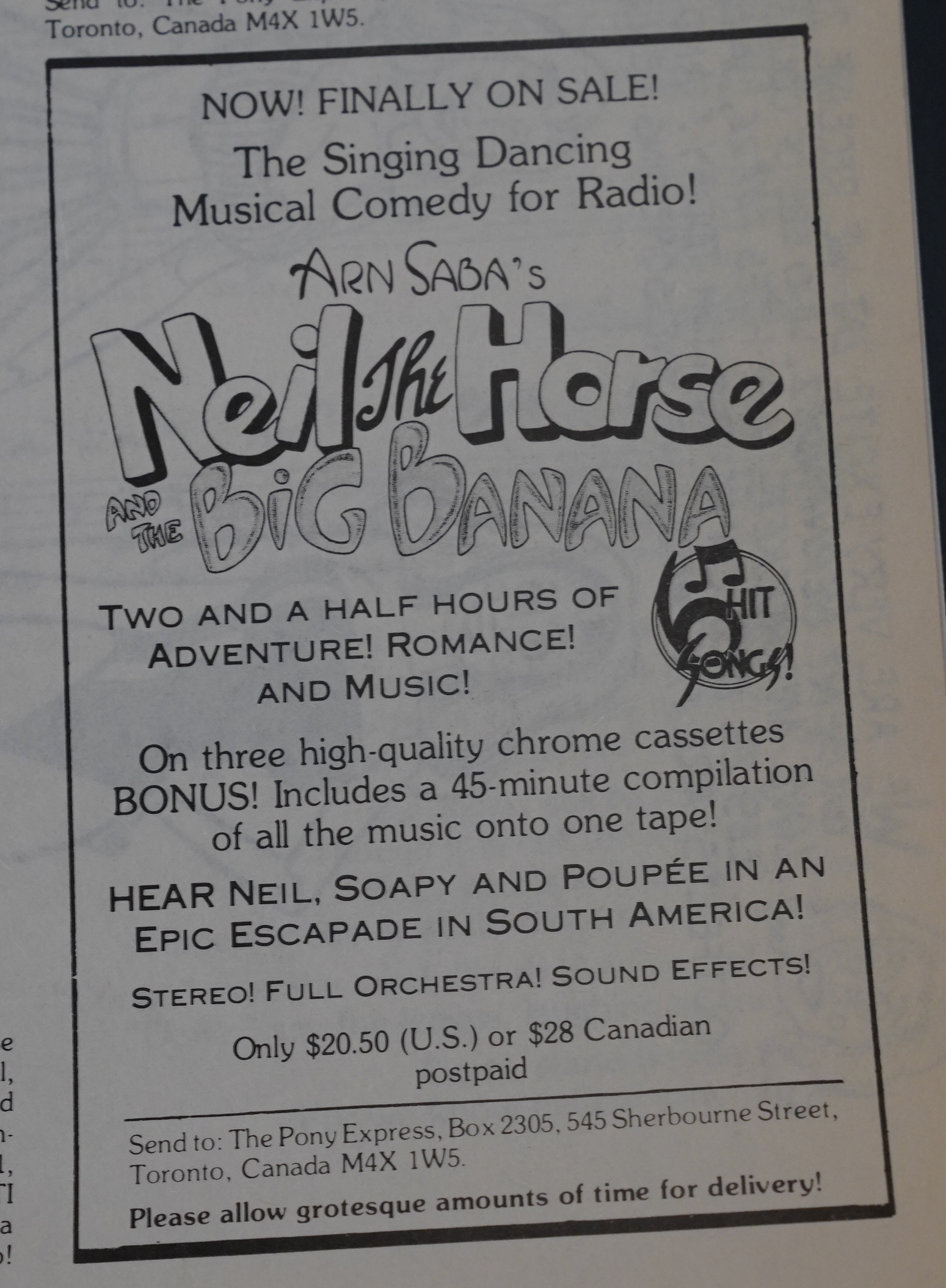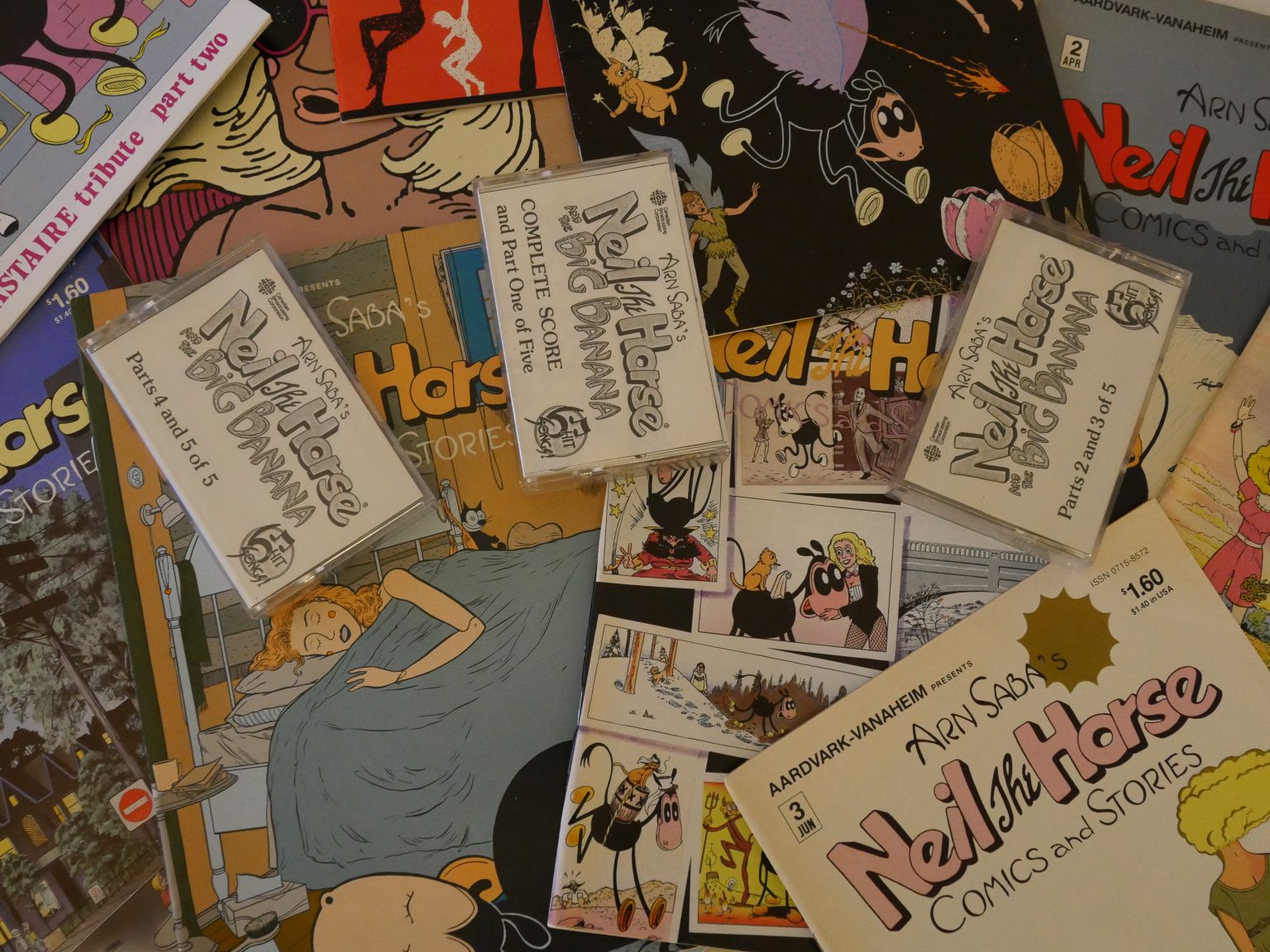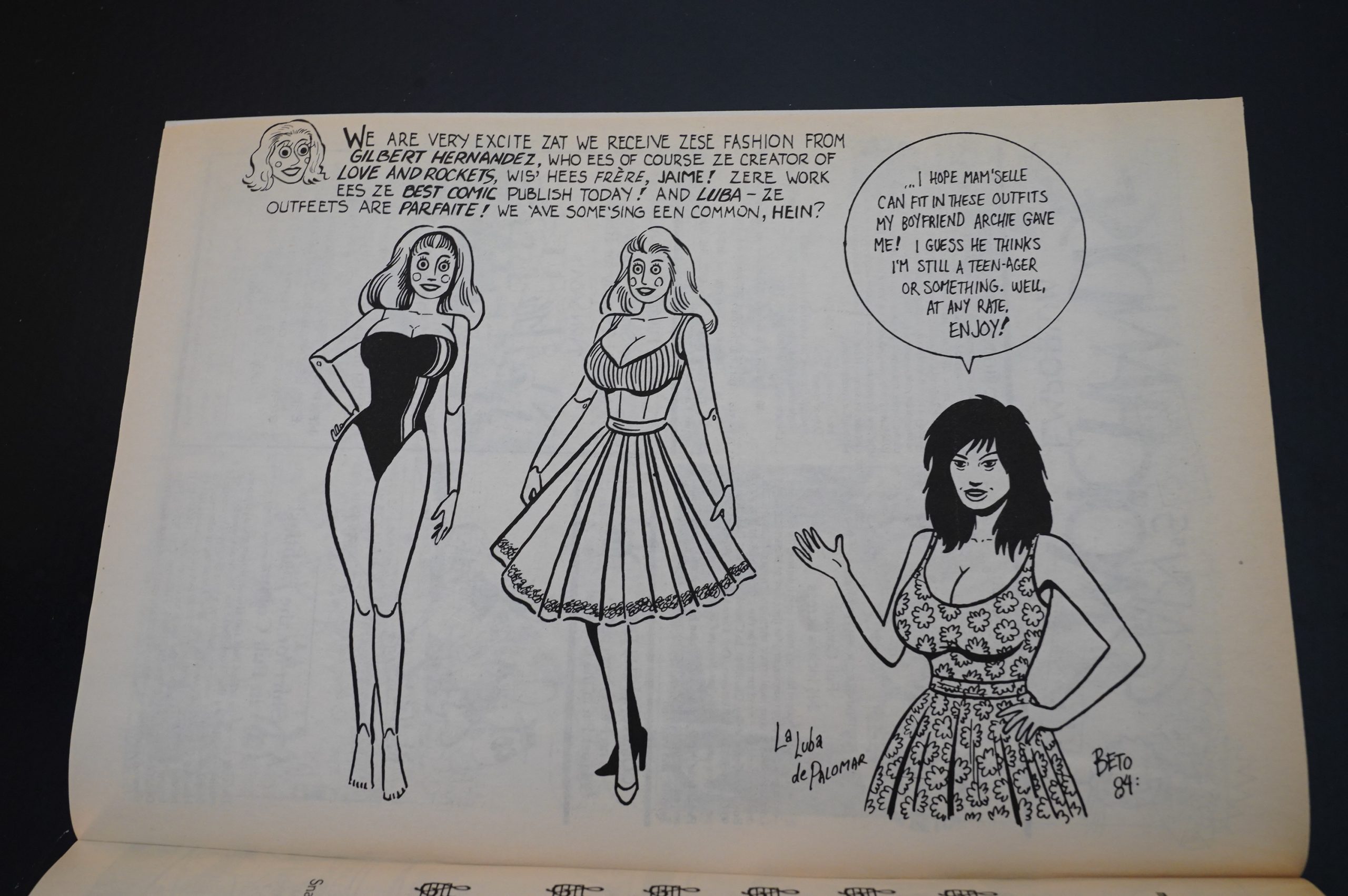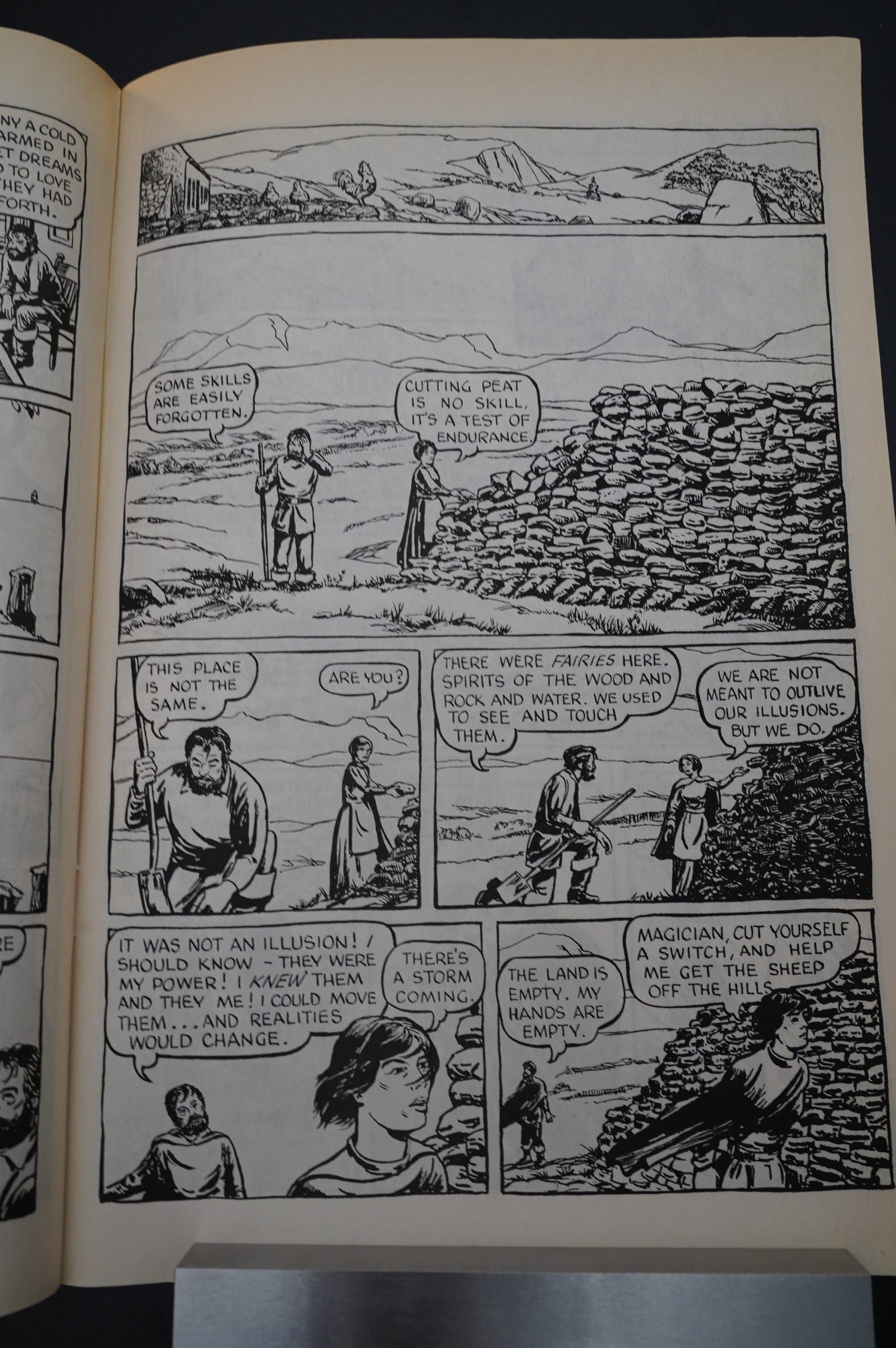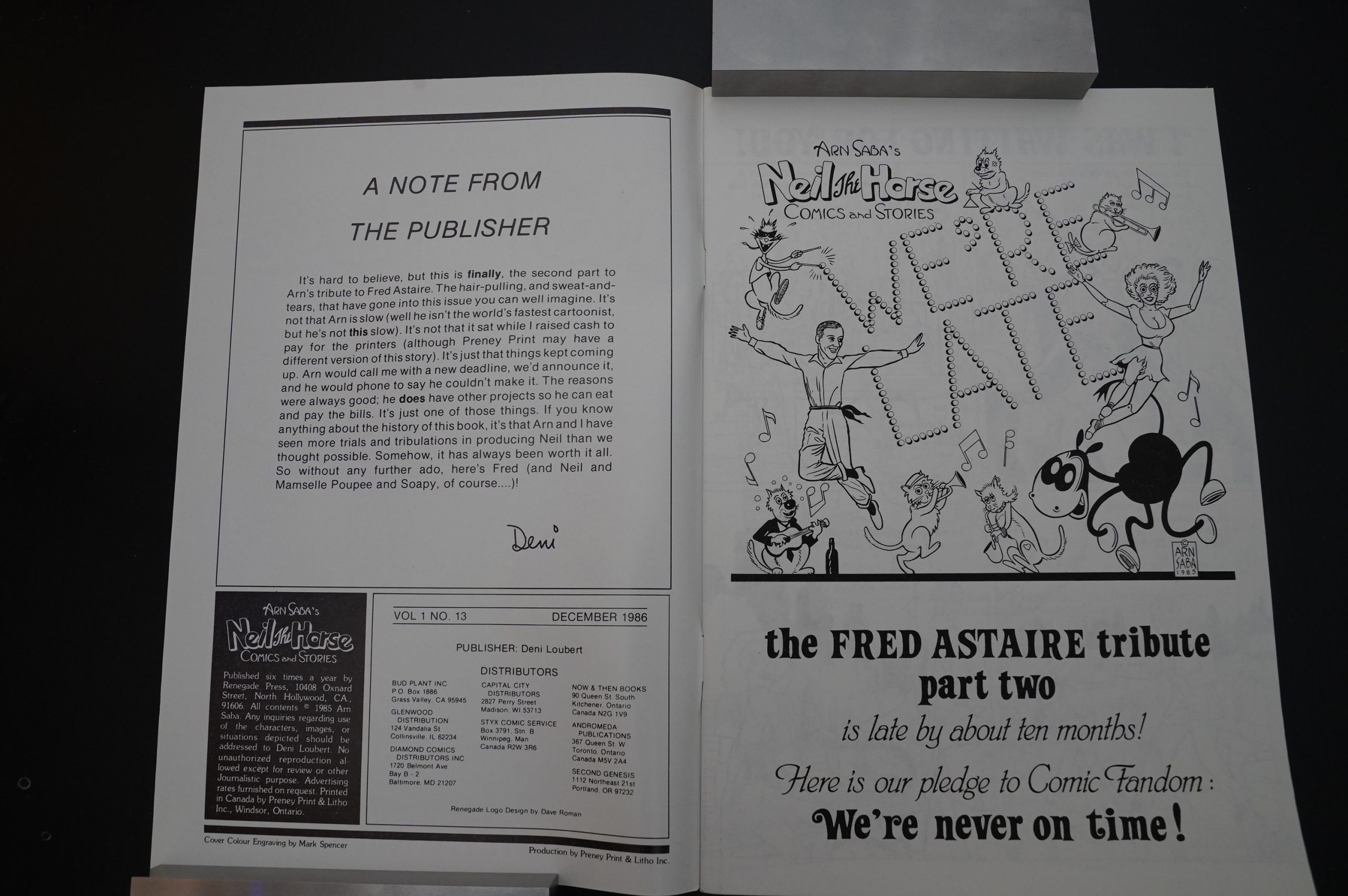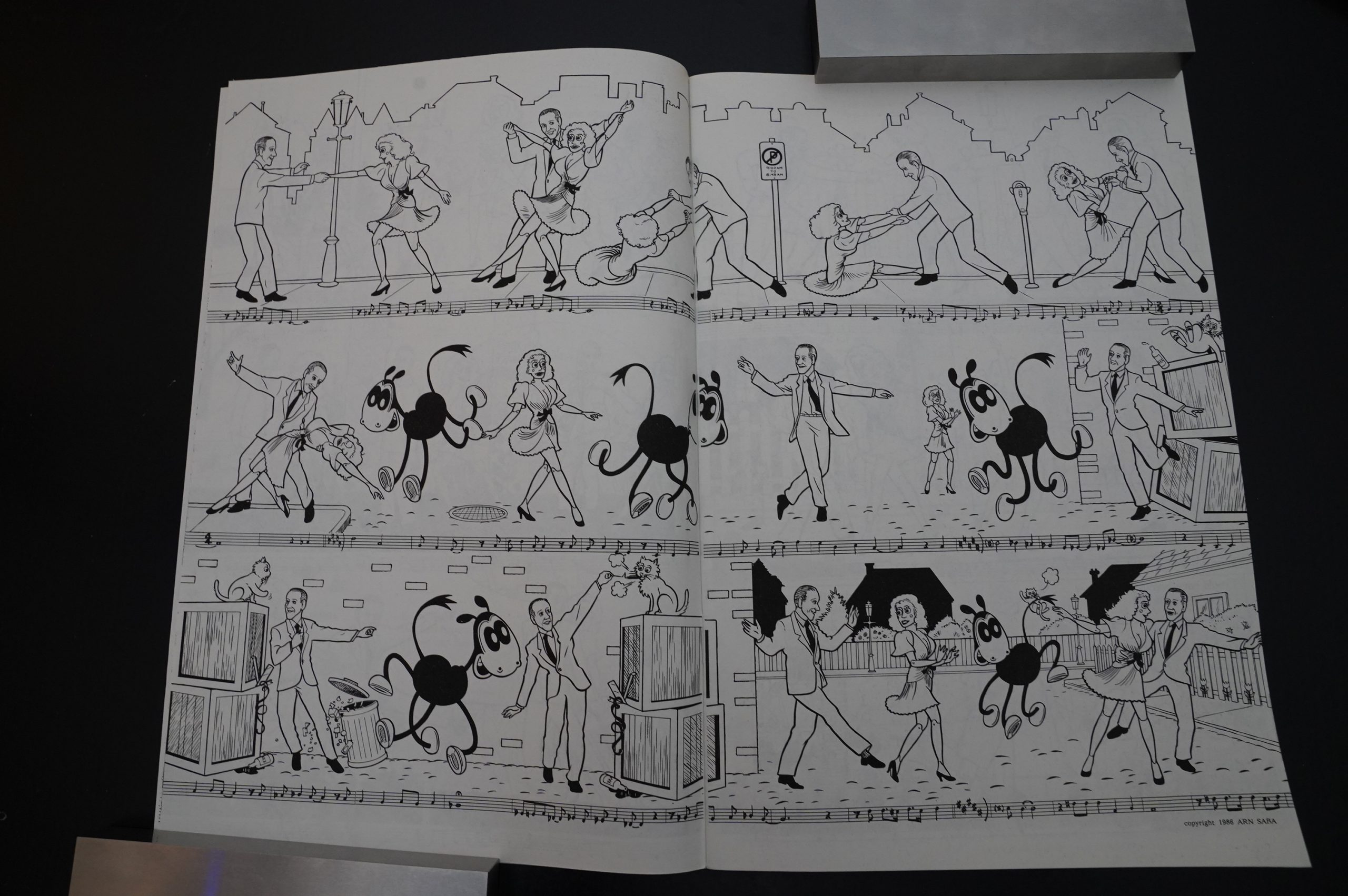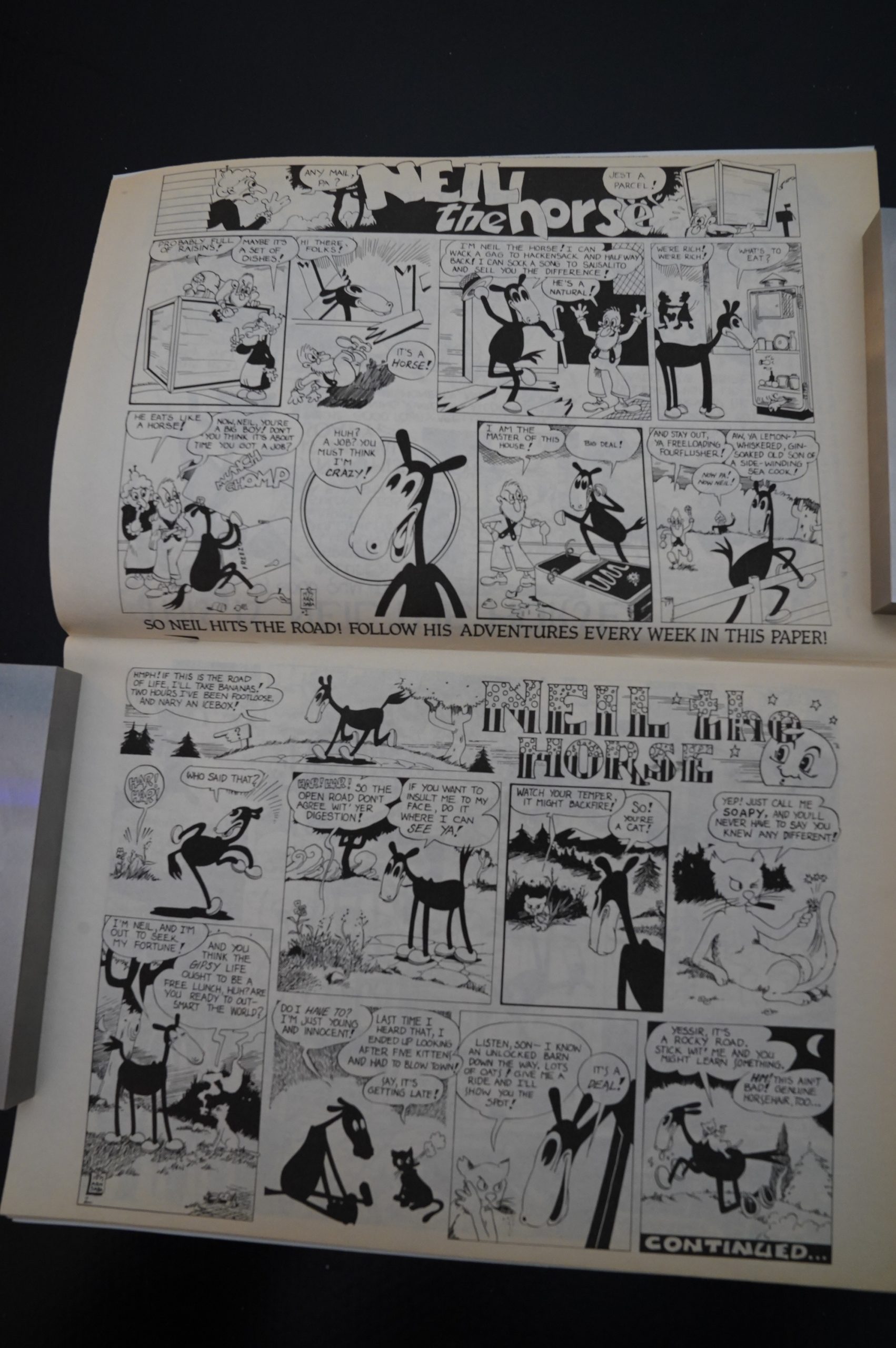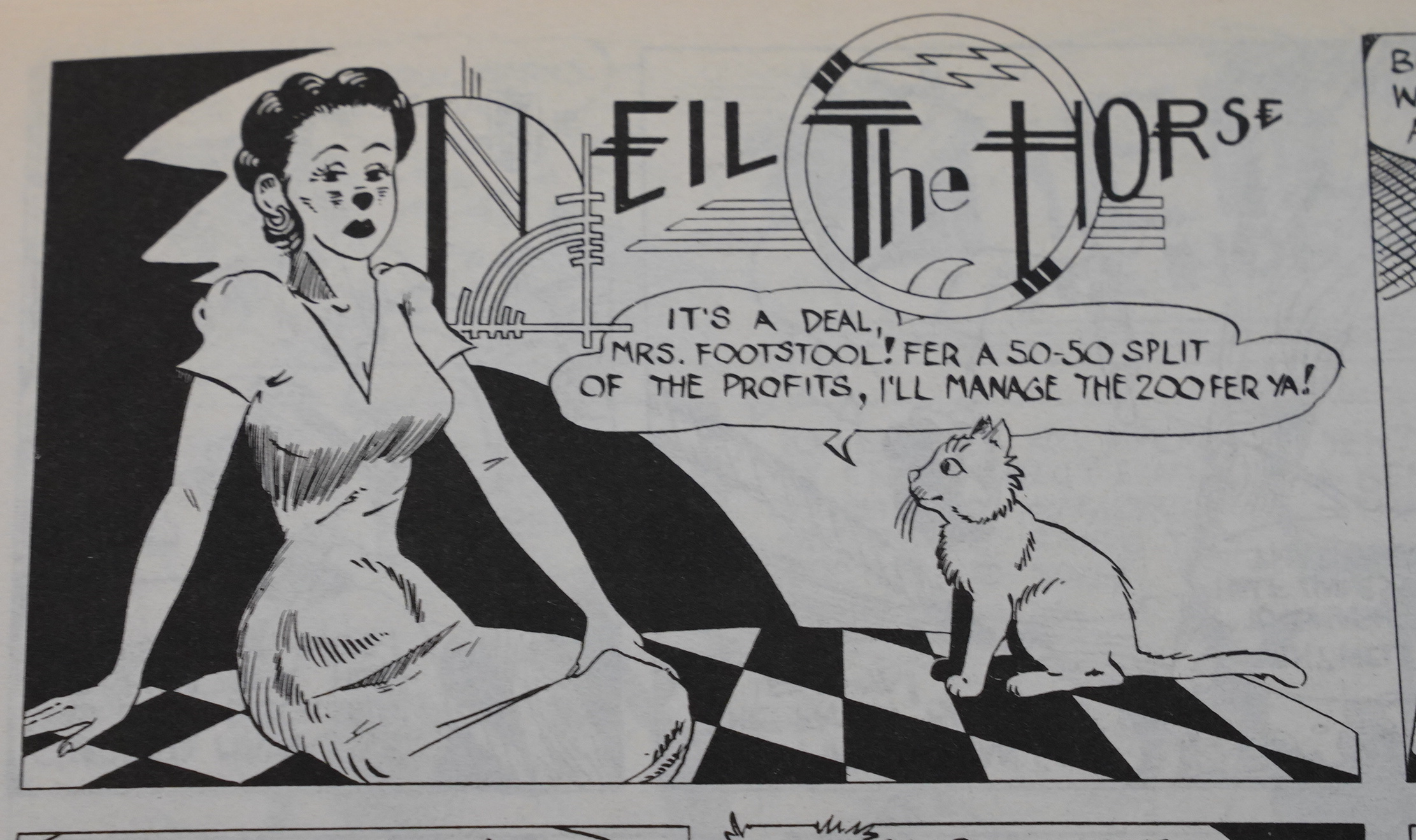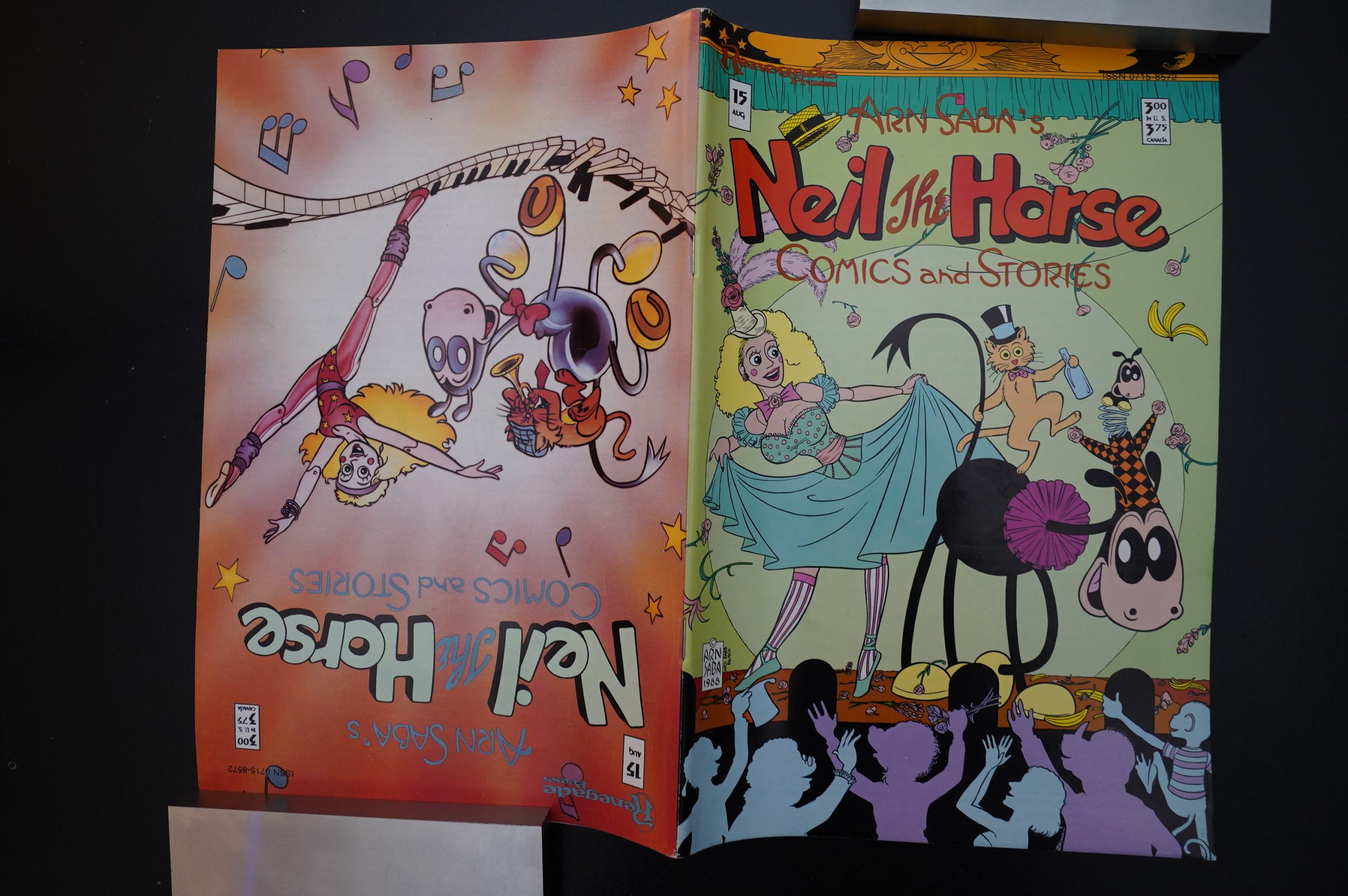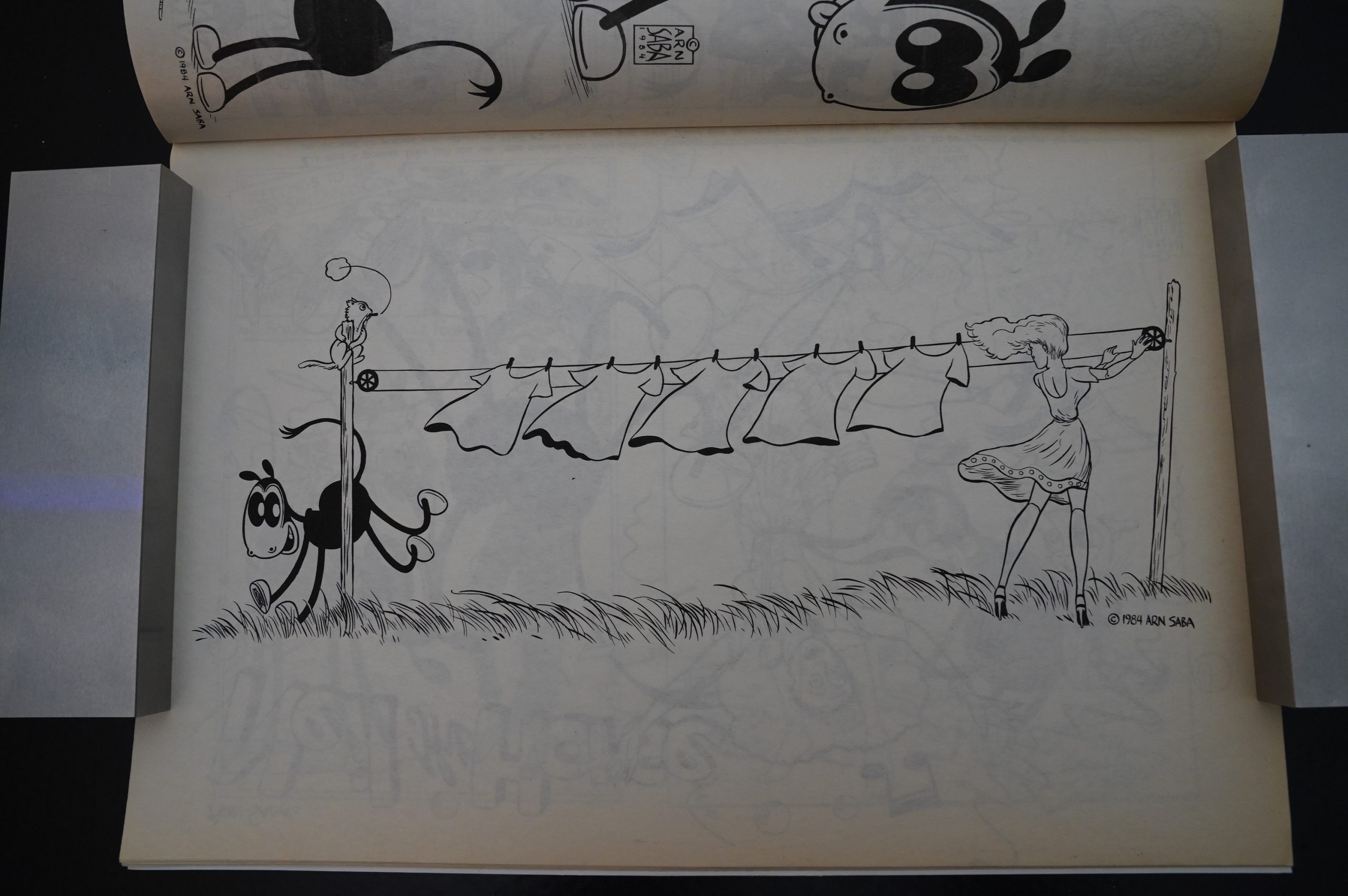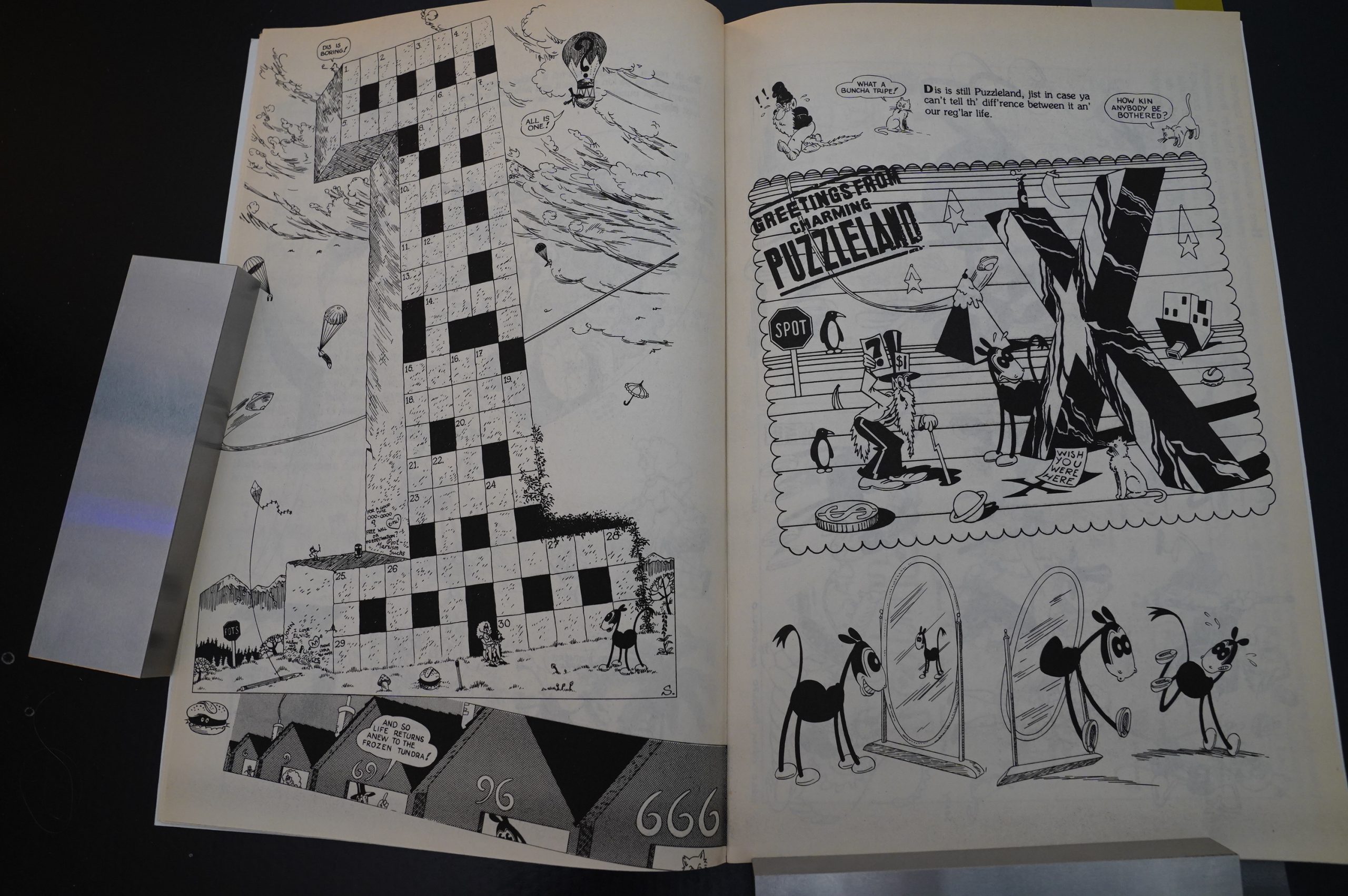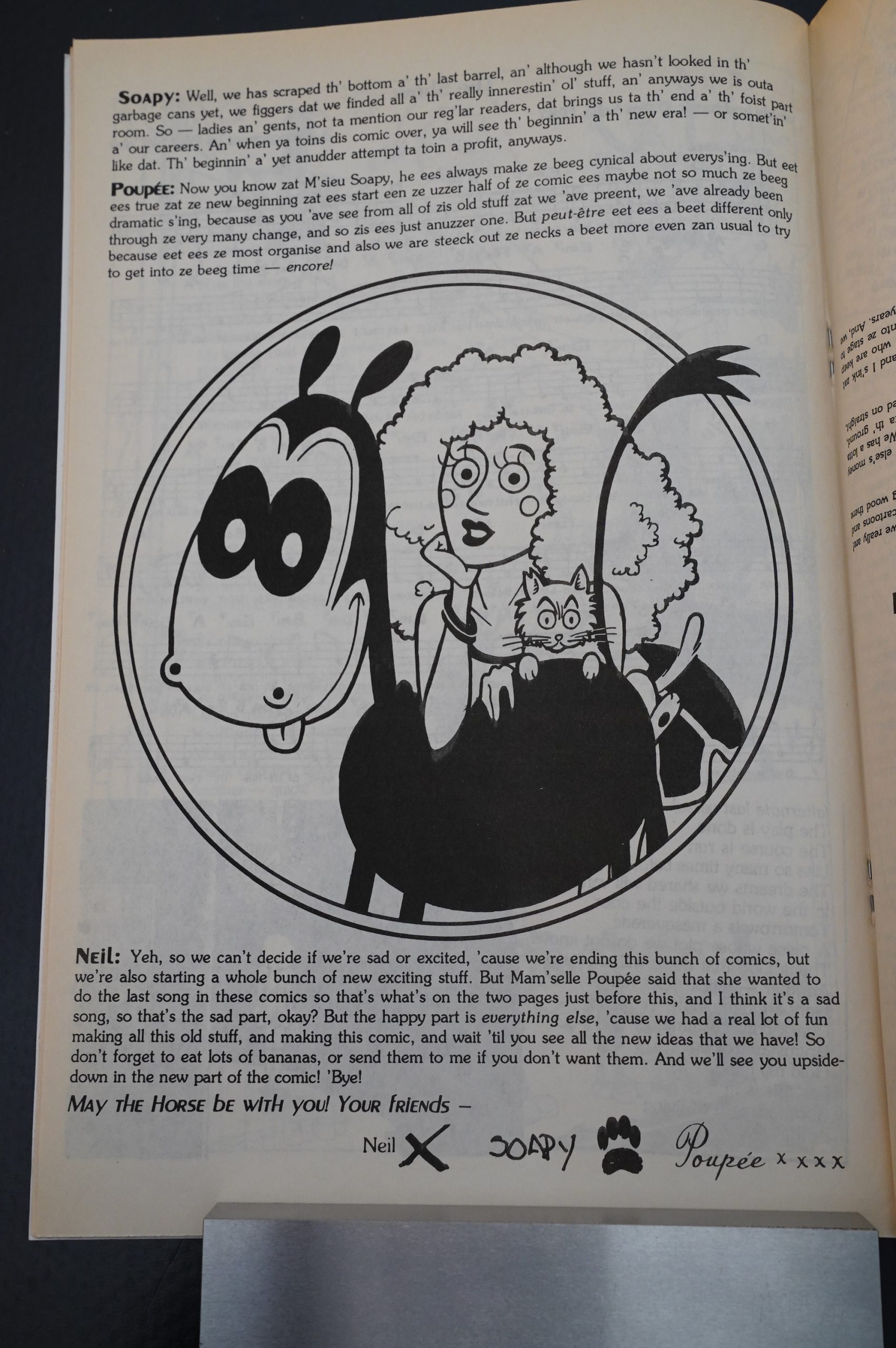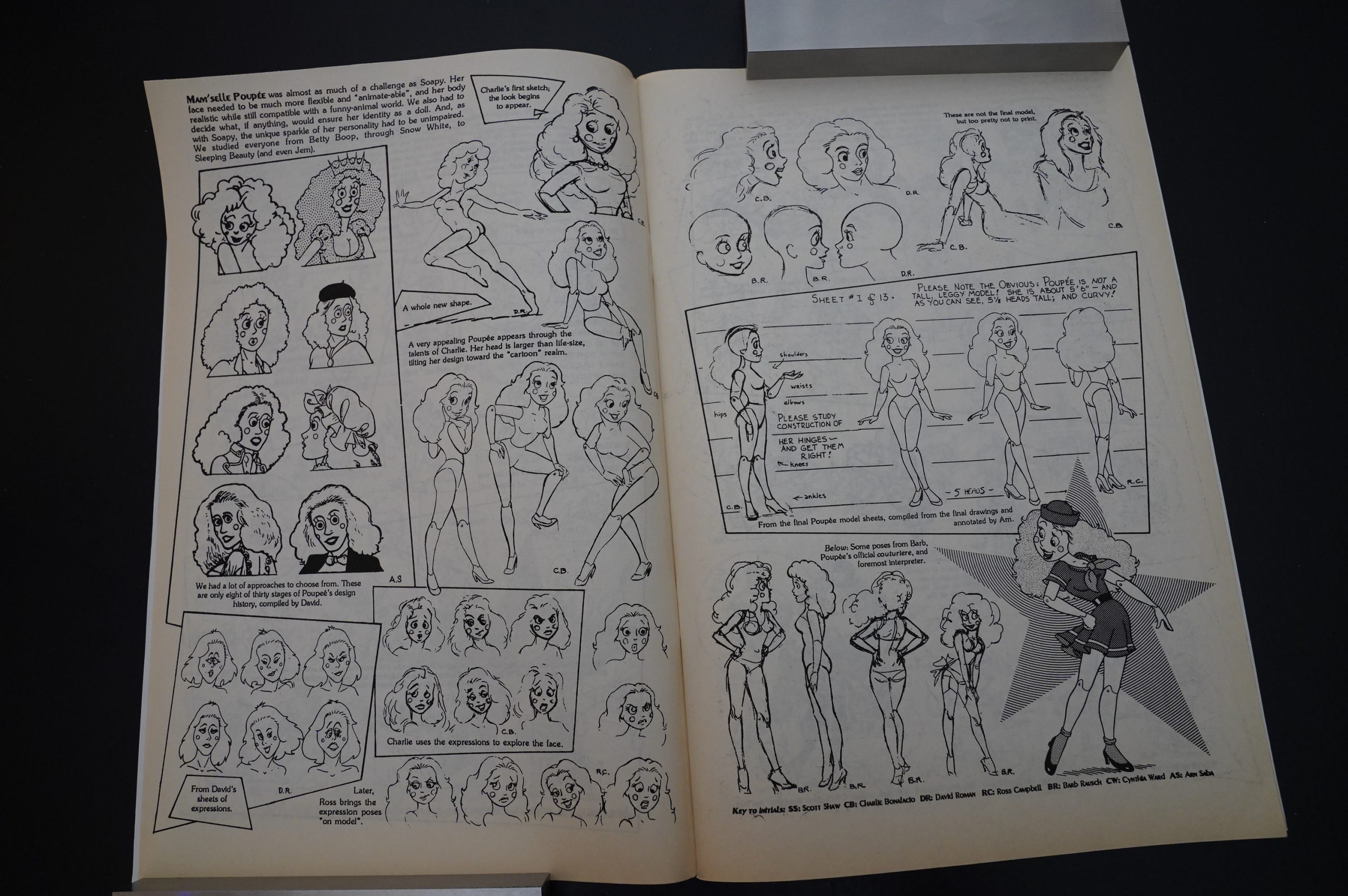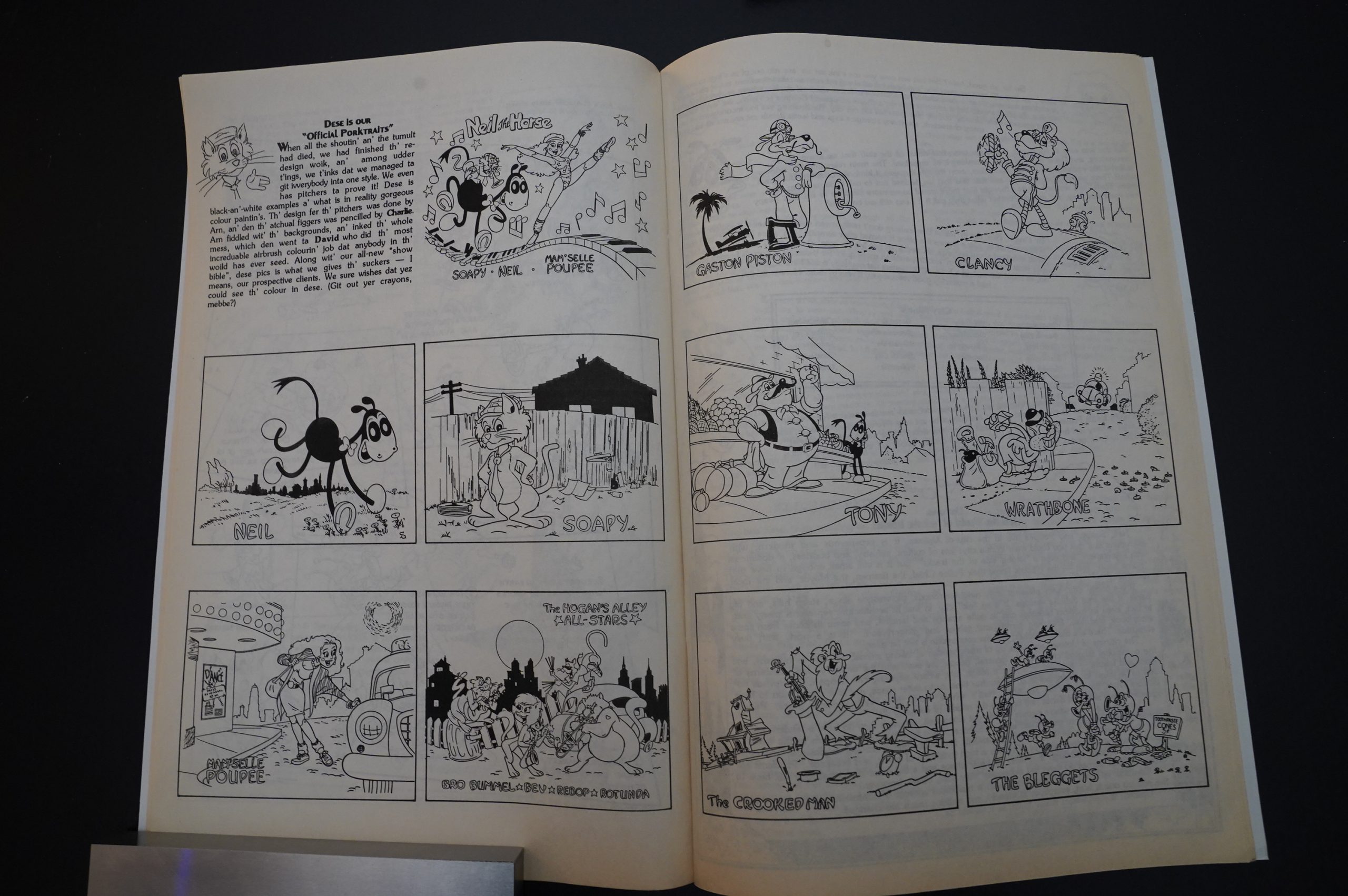Neil the Horse Comics and Stories (1983) #1-10,
Neil The Horse Comics and Stories (1984) #11-15
by Arn Saba with Barbara Rausch, David Roman and others
Ah, Neil the Horse. I was (counts on finger) 15 when I read the first issue of Neil the Horse, and I was absolutely enthralled. It was love at first sight. Let’s look at that first issue:
Deni the publisher gives some background on this: Originally there was going to be an anthology series called Unique Stories, but that didn’t happen. Two years later, instead we have the first issue of Neil the Horse instead.
Saba dedicates the book to Carl Barks… which is surprising in one way: Neil the Horse looks just like something Floyd Gottfredson would have drawn, and not so much as a Barks creation.
(Note: Saba is now Katherine Collins, but for the sake of this blog post, “Saba” seems the least confusing — especially since the recently-published collection is also credited to Arn Saba.)
On the second page, we get some examples from the Neil the Horse newspaper strip, which seems totally bizarre in a kinda wonderful way. 30 Canadian newspapers ran this? Canadians are great.
Then it’s onto the first story, and… Soapy the cat has strapped suction cups to Neil’s er hooves, which enables him to clamber around on house roofs. Because why not!
And here’s the denouement, and here the Barks influences become clearer.
It’s such a wonderfully bizarre story: It starts with a strange premise, and then insists on it so hard that it all seems natural in the end.
The artwork is fun and inventive, the pacing is on point, and it’s really funny.
And then the next page is this!
And then there’s a song! Complete with score!
And then there’s an illustrated prose story (which is the longest serial in the series)!
And then there’s dancing!
And then Neil, Mamselle Poupée and Soapy all address the reader!
And then there’s paper dolls!
All this in 24 pages!
Now, Saba’s obsessions aren’t (and weren’t) mine, but it’s just such a … miniature cornucopia… it’s a complete worldview as a slim pamphlet, and I was sold immediately. I was a fan since I first opened this book, and I’ve remained a fan: I read this series, over and over, as a teenager, and I read the collected edition when it was published in 2017, and I’m re-reading it now.
Saba somehow manages to make these sequences absolutely magical. I wasn’t actually a fan of musicals at the time I read this for the first time, but I’ve become so over the years, and the reason is probably partly because of Neil the Horse.
Just look at that well-choreographed chaos. Just look at it.
Mmm… banana milkshakes… I used to make those, too, as a teenager. Was this where it started? Hm… haven’t had one in years… I should get some bananas and some vanilla ice.
There. Ordered.
When I think of Neil the Horse, what I usually remember is a mood… it’s a quiet, comfortable, cozy mood. But the graphic inventiveness is also something to behold.
Apart from the illustrated prose serial, the longest thing in the series is this one, which gets a proper splash page and everything. It only runs for four issues, though, so while it feels kinda epic, it’s not really that long.
It’s about our band of friends being captured by elves (who seems like assholes to start with), and Neil has to use his awesome video game skillz to save them all. (Yes.) It’s pretty kooky, but it works.
I haven’t mentioned the covers — most of the issues have wrap-around covers. The book is just… way beyond the call of duty; a labour of love: There’s not a single page wasted.
A colour version of Neil the Horse is announced, but that turns out to not be possible. Deni Sim mentions a publishing partner pulling out… which is a shame. I mean, the book looks awesome in black and white, but Saba wanted the book to be in colour, so I’d be interested to see how that’d look.
Isn’t this the sweetest cover? And then you read the newspaper headlines. And then… it’s still the sweetest cover, made even more touching by the precariousness of it all?
I absolutely adore Neil’s face in the second panel up there. It’s 100% perfect Floyd Gottfredson.
And, indeed, Bananas are here to stay.
And then there’s a Conan parody, because why not. (And besides, Cerebus started as a riff on Conan, so there’s a precedent.)
Oh, yeah, I haven’t mentioned the other artists. David Roman is responsible for doing the background on many of the stories (and inks on some), and here’s what his stuff looks like otherwise.
Hm… they certainly seemed to get letters from all over the place…
By issue ten, I felt like Neil the Horse was just on a roll. They increase the page count to 32, which left more room to print stuff contributed by fans. Reading these issues now, it feels like there’s an enthusiasm building, as if Neil the Horse could be breaking out and becoming something huge.
I mean, I didn’t even mind stuff like this.
Barbara Rausch is the third artist involved: She did the pencils on a bunch of stories. And a process page is always interesting.
Oh, yeah, Saba was also doing a non-funny animal thing called Eureka Street in the early 80s… so we get a smattering of those pages here, too.
And then! The first of two Fred Astaire tribute issues! With silver ink on the cover!
It starts off with an eight page bio…
And then lots of dancing. I love how Saba spots the blacks — it’s just so graphically striking.
I’ll be covering this Barb Rausch series later in this blog series…
And then we get a fill-in issue instead of the second Fred Astaire issue… but it’s fine: Lots of new and old funny stuff.
“Please allow grotesque amounts of time for delivery.” As far as I can remember, they arrived pretty swiftly?
Because of course I bought them. I haven’t listened to them in a while, but I remember I really liked them as a teenager. You can listen to them, too, because I uploaded them to Youtube.
Ooo! A page from Beto Hernandez!
Uhm… some of the filler stuff in the filler issue is more filler than other stuff.
“We’re never on time!” seems like a good motto.
But reading this issue now, it feels kinda… deflating? I mean, it’s lovely, but it seems like Saba’s heart isn’t quite as much into this as previously. A year earlier, it seemed like everything was firing on all engines, but this is more like a goodbye all of a sudden. What’s going on?
Three years later the final two issues arrive, and it’s announced that Saba’s dropping the series. By this time, I was at university, and my comics shopping was severely curtailed, and I didn’t actually get these two issues until a couple of decades later.
The first of these two issues (both 64 pages) reprints a bunch more of the weekly newspaper strips Saba did in the 70s. They’re fine — very chaotic, but look really nice. I love that very Barksian woman and the logos (here’s an Art Deco one; they change every week).
And then a double covered one.
One side is more ephemera — here’s a wet t-shirt page.
And… a puzzle page…
And then goodbye. But then! On the other side!
We get an explanation of what happened: Saba wanted to develop Neil the Horse into an animated feature, and has spent years doing character sheets, writing pitches and trying to make it all happen. This side of the book is mostly text detailing how Saba (and other people working on the concept) were thinking, and a few pages of sketches.
This is the most fully-developed art based on the concept. Notice smaller boobs for Poupée and no cigar for Soapy.
And… that’s it.
It’s a lovely series, and I’m glad I re-read it tonight. It’s so sweet.
Conundrum Press published a paperback collection of most of this stuff the other year. I’ve got it, and it’s well made, and I recommend it. Reading the original comics is more special, though.
*sigh*
Heidi McDonald writes in Amazing Heroes #145, page 160:
NEIL THE HORSE
Sapristi! It ‘as been a long time since we
see ze Neil se Horse, non? Just when you
Zink it is safe for putting away ze tap
dancing shoes, it is back zis summer wid
ze last two issues.
Yep, that’s right, Neil #14 and 15 will
be out in July and August. respectively.
Not only will your Neil collection not
be complete without these two issues, but
when you have them, it will be complete!
Tipping the scale at 64 hefty pages each,
these issues print all sorts of stuff from
Neil’s past, and point the way to what
creator Arn Saba calls “Neil Mark II.”
“They’re a wrap up [of this phase),”
says Saba. “As far as I can say, they are
the last Renegade Press issues. Next time
we see him, it will be a completely
different format. [The issues] consist of
old material, but either stuff that has
never been published at all or [in very
obscure sources]. It will be all sorts of
stories and drawings, so that anyone who
has all 15 will have everything of Neil
the Horse, up to this date, that I consider
worth having. There’s nothing left un-
annotated.”
Neil story—a 35 page sequence of the
old Neil the Horse syndicated strip, from
way back in 1975, featuring how Neil and
Soapy met, the first appearance of
Gaston Piston, and other epochal events.
The Neil strip actually ran in Canadian
newspapers for several years, first as a
continuity strip, and then as a gag strip.
Issue #15 will include all of the gag strips
that have yet to be reprinted. (That leaves
one huge 75-week pirate adventure story
unreprinted, and, in fact, Saba has no
plans to do so). There’s also a 16-page
portfolio of various drawings in #14.
Issue #15’s highpoint is sure to be an
all-new 32 page feature that will answer
the question you all must be asking
yourselves—What have Arn Saba & Co.
been doing for the past two years,
anyway? Trying to bring the Neil the
Horse cartoon show become a reality, is
the answer.
“One half of is the story of things
that have happened over the last two
years, since April l, 1986, when I set
atX)ut this gigantic project to develop and
redevelop Neil for animation,” Saba
recalls. This tell-all is nearly a primer
on trying to get an animated sh(N on the
air. “Lots of drawings, all sorts oftEhind
the scenes stuff on how we redesigned
the characters, excerpts from the stories
. for the people who really want to
know every last detail of what Neil and
I and the gang have been up to, there it
is.” Indeed, Saba has pursued this goal
with nearly single minded intensity—at
one point he had nearly ten people
working for him—including Dave
Roman and animator Charlie Bonaficio,
who did a great deal of working re-
designing the characters. Neil himself
has been merely fine-tuned, but Soapy
and Mam’selle Poupee have undergone
a bit more of a transformation, as the
illustratiOn below shows.
As Neil & Co. have gone from
network to studio and back again, there
has been all sorts of re-thinking and
redefining. Of course, the inevitable
question is raised of whether trying to
find happiness on network TV has forced
Saba to compromise his vision. “Only
in very minor ways. My biggest com-
plaint is scrapping Soapy’s cigar.”
[Animation studios balked at the idea of
a cigar-chomping kitty cat as a children’s
character). In fact, Saba feels all of the
fine-tuning has enable him to become a
more disciplined creator.
“If you’re not going to entertain your
audience, you’re not going to go very far.
I’m uorking as an entertainer. I’ve
learned my craft better. I don•t feel I’ve
compromised myself. Far from it. I’m
extremely excited. It’s a much much
better project.
“People thought Neil was gone but
nothing could be further from the truth,
says Saba of all this little known activity.
Arn Saba’s redesigned Neil the Horse and friends.
“Now we’ve decided on a new exciting
direction for Neil and we’re not sure
what we’re going to do now. But we’re
ready to go.” Indeed, although the exact
nature of Neil’s next appearance is
unknown, there are currently several
studios and publishers interested in him.
It seems only a matter of time before
Saba’s dream of an animated Neil the
Horse is realized. And he doesn’t regret
all the time and money spent. “I would
never want to look at my life and say
‘Well, maybe I could have done it.”‘
Somebody writes in The Comics Journal #86, page 56:
I first saw Neil the Horse four years ago in
the form of just two comic strips in an
obscure fanzine (kantarama) which I had
come by purely by chance. Just two strips,
but Saba’s name was permanently etched
in my mind as one to remember. “This
Saba fellow is going to go places,” I
thought, “‘and when he does, want to be
there.” Well, he has, and I am, and it was
worth the wait.
The first three issues of Neil the Horse
Comics and Stories (Aardvark. Vana-
heim) contain a dizzying array of different
forms—comic strips, comics stories, illus-
crated stories, a kind of Big Little Book,
poems, single page illos., songs and paper
dolls. This variety leads to an inevitable
unevenness, although Saba’s style is
remarkably consistent whatever the form.
Neil is certainly a literate book, both com-
ics and otherwise, displaying the influence
of and references to Barks, Gottfredson,
Johnny Gruelle, Fred Astaire and Ginger
Rogers, Marcel Duchamp, Mao, and the
early Disney, Warners, and Fleischer car-
toons where flowers, birds and cute little
animals sing their hearts out.
The best thing about Neil is the oddball
world it lives in. As in all the great books
and strips, Saba has created a unique uni-
verse for his characters to romp through.
His Characters are charmers, too: Neil, the
lovable, naive, happy-go-lucky banana-
lover (who, as a letter writer suggests, must
sound like Red Skelton’s Clem Kadiddle•
hopper), Mam’selle Poupee, a beautiful doll
who’s searching for true love, and cigar-
chomping Soapy the Cat, who’s Brooklyn
tough on the outside and Brooklyn tough
ton the inside, too.
There’s a lot of gentleness and a just
plain good feeling in Neil which is a welcome
relief from the inhumane, relentless
violence that increasingly fills the world of
comics. But there’s also an undercurrent of
looniness and grouchiness that prevents
things from sinking into saccharine.
Yet, while the details of Saba’s art are
delightfully whimsical, and his storytelling
is excellent, his actual drawing style is often
stiff, and this constraining rigidity some-
times prevents things from bursting into
full lunacy. The characters have a rather
narrow range of expressions. Soapy’s anger
is rarely alleviated by anything else.
Poupee’s big-eyed doll’s face has a huge un-
changing smile that is sometimes grating.
And though Neil has a wider range than
the others, there’s still something held back
about him. His legs—simple black pipe
cleaners—should be a steady, abstract
rhythm, but mostly they just seem to be
ing all over the place. This is a pretty fussy
criticism, I know, but many times I have a
frustration with Saba’s work. I want it to
cut loose from the paper into the realm of
pure expression, the way Herriman and
Sterrett do, and it doesn’t. I would be
unreasonable in expecting this if there
weren’t times that Saba does it![…]
Saba’s whimsy seems to work best in
short bursts. The individual comic strips
are perfect, or nearly so, but when he
tackles a longer story, he tends to wander.
The afore-mentioned “Neil the Horse
meets Mr. Coffee Nerves” has a terrific idea
—Neil is led down the path of insidious caf-
feine consumption by the nefarious Mr.
Coffee Nerves and his assistant Wrathbone
(this pair reminds me of Foulfellow and
Gideon from Disney’s Pinocchio) with mad-
cap results. The individual parts of the
story—the opening page, where a city is
obsessed with coffee, Neil’s drop into a vat
of dough—are wacky enough, but as a
Whole the Story doesn’t really hang to-
get her.
In spite of my reservations, adore Neil
the Horse. In it there is much that is
looney—Max, the little in
“Sur les Toits de Bananaburg” who goes
around with a pacifier in his mouth saying
and looking astonished or Percy
Platypus who “Pops Pills and Pounds
much that is lovely—
“Horse Descending Staircase” or the single
illustration accompanying Another High-
way Song.” When Saba’s bad he’s like cot-
ton candy—it’s sweet (l do not mean this in
a pejorative sense) but it melts in your
mind. When he’s good, he’s transcendent.
I wish there were lots and lots and lots
more comics like Neil the Horse, by which
don’t mean comics about horses, cats, and
dolls, but rather comics that take place in
their very own world and not Stan Lee’s. If
there’s one thing that comics have always
been filled with, it’s personal whimsies.
And, unbelievably, almost tragically, Neil
is the only comic being produced that’s
about whimsy. As Mam’selle Poupee put it
on the letters page of “You ‘ave not
seen nussin yet—zere weel be ze music and
ze dancing girls, and ze laughs an ze broken
‘earts.”
Sacre cæur! Who could ask for anything
more?
Somebody writes in Amazing Heroes #156, page 13:
NEIL RUMOR PUTS CART BEFORE THE HORSE,
SABA SAYS ANIMATION NOT HIS MANE CONCERN
Whether Brandon Tartikoff tells the
smurfs to take a walk or not, Arn
Saba’s Neil the Horse, which was
rumored to be slated for an animated
series, will remain a creature of the
printed page for the present.
Saba left Renegade Press, which
had published his Neil the Horse for
15 issues, in August to work on other
projects, including a graphic novel, a
color mini-series, some children’s
books and a one-shot adventure story
for Pirahna Press.
“Where it stands now, I’m putting
animation on the back burner for
awhile,” Saba said.
Saba said in a press release that
there had been a misunderstanding
between Renegade publisher Deni
Loubert and himself which led to
Renegade running an advertisement
proclaiming Neil was slated for an
animated TV series.
Saba admits that some serious talks
are underway involving Neil’s anima-
tion and he said that Marvel Produc-
tions had optioned to begin produc-
tion before they took an economic turn
for the worst.
“I must be the only person in the
world who actually got money from
Marvel Productions and didn’t get
screwed.” Saba said.
Although Saba said he doesn’t want
to reveal the names of publishers he’s
been negotiating with about a Neil the
Horse graphic novel, he did say that
it would probably be a 46 to 48-page
long quest story.
“I’ve been banking up stories,” Saba
said. “I’ve got an Arabian Nights
story, a Roaring ’20s story; all kinds
of adventures.”
Saba is also currently writing four
or five children’s books, each in a dif-
ferent style, each appealing to a dif-
ferent age-group.
“We’re going to write them, lay
them out and do a couple of water-
color paintings for them and then try
to find a publisher,” Saba said. “It’s
a big gamble with no publisher in
sight.”
Although Saba said that comics are
his first love, he felt compelled to
escape the “comic ghetto” after Neil’s
15th issue for Renegade.
“I was a small fish in an even
smaller pond, where nothing sells if
it doesn’t have violence,” said the man
who would make the world safe for
musical comedy. “That’s just no way
to make a living.”
It took a massive mental adjustment
to move into other mediums with Neil,
according to Saba, who has been
trying to conceive of his equine buddy
in terms of text these days instead of
as a series of pictures.
“In the end though I couldn’t stay
in a business that practically ignored
my existence, where the only funny
animal artist to really become popular
was Carl Éarks, and he had Disney
behind him,” Saba said. “That time
at Renegade, being ignored, was the
worst experience of my professional
life.”
The last issue of Neil began the
horse’s adaptation to other mediums,
specifically animation.
“Part of adapting characters for ani-
mation is redefining the world they’re
in,” Saba said. ‘ ‘For 32 pages of that
final issue we took Neil the Horse
apart like a radio, dismantled every
component and then put them back
together.”
Saba said that this redevelopment
will be useful even for any future
comics projects because he under-
stands how the character works more
fully now.
“So we did plan for animation, but
I’m not too keen on Saturday morn-
ings,” Saba said. “The more I know
about the networks, the less I like.”
Until Neil gallops again however,
whether it be in childreis books, cel
by cel, or panel by panel, Saba has
plans to adapt some more serious sub-
jects to the comic form. He describes
his project for Pirahna Press as a high
9dventure story, a “combination of
Prince Valiant and Albert Camus.”
No matter what project resurrects
the beloved Neil, Saba said that David
Roman and Barb Rausch, who were
instrumental in the Neil comic book,
will be a part of them.
“They’re my permanent team for
anything,” he said.
Kim Thompson interviews Saba in The Comics Journal #99, page 64:
THOMPSON: You must have come across
this at conventions: You’re sitting with Neil
the Horse and sketches spread Out in
front Of and a kid •eulks by and sort of
glances at the table, sees that it’s funny
animals, and immediately looks awa•,•. Does
that bother
SABA: ScornfUI or disinterested… No,
not really. might like to kill the kid but
[laughter] other than that it doesn’t bother
me at all. No, it doesn’t bother me very
deeply. What bothers me more is when
Who ought to know better don’t pay
attention. Now that may be a very rude
thing to say, maybe I’m overestimating
myself, but so many times I’ve gone into
publishers, originally comics. publishers,
now at least Thank God they pay attention
to me, but now I go to book publishers try-
ing to get Neil into children’s books, and
they don’t read it, don’t pay attention,
they get a flash off the image and that’s it.
People who ought to look, who ought to be
open, those people really annoy me. don’t
blame kids for anything. It doesn’t get
under my skin. I’ve had so many years Of
nobody paying attention to me at all that
the fact that three middl&aged women will
come up to me at a convention [laughter]
I’m thrilled! That’s wonderful! I do get a lot
of older people. It’s really quite funny, fhe
audience I get is not exclusively adults, I get
quite a number Of teenagers, more recently,
which is nice, and I do get some kids, which
is great, mostly letters from kids, but by far
the majority of the audience is well over 30.
THOMPSON: so don’t con-
sider Neil a children’s book.
SABA: Well, I do and I don’t. I think that
who I write it for is the child who I think I
was, who I remember being. A charming,
sensitive, literate, intelligent [laughter)
child… sophisticated! Well, I’m writing
what I think I would have been amused by
as a child, similar to the things I was
amused by as a child. Barks, obviously; a
lot of children’s books like Doctor Doolittle,
Freddie the Pig, The Oz books, Alice in
Wonderland, The Wind in the Willows, Peter
Pan, Pooh, Rupert the Bear, an English
comic I just loved, all those things… I
grew up on 1930s Caniff strips because my
mother had saved them all when she was a
kid. I’ve got them now, it’s wonderful.
Or four years running. That was a
contemporary strip to me growing up in
the ’50s. So that and Barks and Rupert the
Bear, things like that. I was six years old,
and I can still read them as an adult
and I would like to do stuff that works on
that level and I certainly have had children
who really enjoy my stuff. I get enough let.
ters from children and have seen them read
it and listen to the play that I know it does
work for at] least some children. don’t
write just for children and I don’t write just
for adults. I don’t have a target audience in
mind, I reallydon’t. [write what I would be
amused by. And I think that I’m enough of
a kid that it works for kids.
I might misunderstand children today.
They’re much more oriented toward video
and TV and movies and a different style of
entertainment. A lot more violence. A lot
more serious issues even.
What I really detest in children’s lite-
rature—l shouldn’t say “detest,” that’s a
Strong word. What I find myself uncom-
fortable with and don’t like is these issue-
oriented books you see, things like
somebody’s parents get divorced and the
13-year-old girl gets very upset by it, or
what to do if you discover your father’s a
homosexual. If I was a kid I wouldn’t want
to know that, Well, maybe I’d want to
know the fact but that’s not my idea of
entertainment. That’s not my idea of fun!
Jesus! That’s boring shit, that’s not enter-
tainment.
Dave Sim writes in Amazing Heroes #157, page 11:
1 got in NEIL THE HORSE and
IS, and I thought they were just amaz-
ing—particularly #14, because the
whole time I was involved with pub-
lishing Neil the Horse I had been
pushing for [Arn Saba] to go back and
reprint some of the really early mate-
rial; like a lot of the guys, particularly
the bigfoot cartoonists, he was reluc-
tant to have the really early stuff pub-
lished. I thought the first serialized
Sunday page story was really, really
good. It was exactly what I thought
it would be; that’s why I kept trying
to persuade him to publish it! It’s like
a really good Disney/Warner Brothers
cartoon on paper. And I was really im-
pressed with all the daily-format strips
he printed, and some of the text
pieces. This is another one where I
can’t figure out why it doesn’t sell
better. It was a hell of a package.
[Mitor’s Note: Two publishers are
scheduling Neil the Horse one-shots
for the summer of 1989, both featur-
ing new material.]
That didn’t happen, unfortunately.
Bob Levin writes in The Comics Journal #255, page 67:
While Saba’s work might seem a con-
fection — all feathers, pixie dust and
chocolate jimmies — he blended into it a
pinch Of bleakness borrowed from Celine
and a dollop of moral purpose worthy of
Camus. At various times, in various
forums, he announced his intent to
unearth “the dark side Of human nature,
to transform “the dross Of human exis-
tence.” “to make the world better against
all Odds. ” Instead of walloping one anoth-
er, his characters would act reasonablely,
behave nicely and everyone would end up
happy. And his work, he said, would
instill “values” in his readers, not burden
them With “relevances.” He was not after
an “issue-oriented” book, where “some-
body’s parents get divorced or you
discover your father’s homosexual.” That
was “not (his) idea of entertainment. ”
None Of this, in isolation, had the
impact, say, Of Serrano’s Christ-in-piss;
but the cumulative effect, even among the
corner Of the comic-book market accus-
tomed to the more predictable offenses of
the alternative avant-garde. caused people
to wonder just What the hell was going on.
His work, one comics reader remembers,
“was so unlike almost everything else that,
While not a candidate for the pantheon,
something about it lingered. It was quite
the enigma. “It was all flying animals and
wooden women,” another says. “It would
Win the ‘Most Likely to Have What the
Rest of Us Would Consider ‘Issues’
Award’ every time. ”
Like I mentioned above, Conundrum reprinted Neil the Horse a few years back, and it did get quite a bit of positive press:
It was time to go. Every boom must have a bust, and the black-and-white comics boom was over. A comic that may have sold six thousand copies in 1985 sold half that much by 1988. For five years, Arn Saba had made the world safe for musical comedy. Neil, Soapy, and Mam’selle Poupée should have been hoofing and singing their hearts out on a Broadway stage, and perhaps someday they will.
Or this one, who doesn’t seem to have actually read it:
A nostalgic throwback to the era of movie musicals, fast-talking screwball comedies and adventure comic strips
This blog post is part of the Renegades and Aardvarks series.
